| |||||||
| Search Forums |
| Advanced Search |
| Go to Page... |
 |
| Search this Thread |  1,743,172 views |
| | #1 |
| Team-BHP Support  | 2018 Ford EcoSport Facelift 1.5L Petrol : Official Review The Ford EcoSport Facelift is on sale in India at a price of between Rs. 7.67 - 11.20 lakhs (ex-Delhi). What you'll like: • Still the best Compact SUV in the segment • Not merely a facelift; this update brings a lot of meaningful improvements • Good looks matched to solid build quality • New 3-cylinder petrol is quick, revv-happy and offers excellent driveability • Loaded with kit (leather seats, paddle shifts, auto headlamps & wipers, cruise control, reversing camera) • Smartly packaged interior. Adequate space for 4. Lots of storage & practical features • Dynamically sorted. Competent handling by SUV standards • Safety kit includes 6 Airbags, ESP, Hill Hold, EBA, ABS & more What you won't: • Has gotten very expensive with time. Not VFM, but not overpriced either • 3-cylinder motor can't match the competition in refinement (especially while idling) • All-rounded diesel is priced just ~70k above this petrol; 1.5L TDCi remains our top choice • Ride quality isn't plush; underlying firmness obvious, more so with the 17" rims • Narrow cabin width makes a 5th occupant unwelcome. Best for 4 onboard • Tree trunk thick A-Pillars result in severe blind spots • Some features deleted from the older car (lumbar adjustment, reclining rear seat, cooled glovebox…) Last edited by GTO : 20th March 2018 at 08:57. Reason: Petrol MT now launched in the top variant, so removing that point |
| |  (86)
Thanks (86)
Thanks
 |
| The following 86 BHPians Thank Aditya for this useful post: | aabhimanyu04, ajishanand, aniket17, Anupam1024, arunphilip, AShubrah, Avikbrio, BlackPearl, CarguyNish, chinmaypillay, ChiragM, chiranjitp, Col Mehta, Contrapunto, Cyborg, daretodream, deetjohn, dpkbehera, Dr.AD, dZired, espraveen, Flyer, FueledbyFury, gauravanekar, Govardhansupra, Grand Drive, GTO, hiren.mistry, InControl, Jaggu, jithin23, Johnnny, karan561, Karthik Chandra, Keynote, lemedico, Leoshashi, libranof1987, MDED, MSAneesh, myavu, Myth_sx, Nagato710, narmad, naveen.raju, Nohonking, noopster, Obi-Wan, Omkar, paragsachania, phoenixash, PrasunBannerjee, R-Six, Rakshith220, RavenAvi, ravib, roby_dk, romeomidhun, rpunwani, ruzbehxyz, S.MJet, samabhi, samaspire, Samba, sayakc, searacer932, Shanksta, shipnil, Simhi, smuniswami, sparky@home, strawhat, suhaas307, sunny29584, swiftnfurious, The Rationalist, theexperthand, timussharma, TusharK, vaasu, vaish9925, Varun_HexaGuy, vb-saan, vikred, vredesbyrd, X_T_A Rose |
| |
| | #2 |
| Team-BHP Support  | Since the Ford EcoSport has already been reviewed by Team-BHP, this report will only focus on changes made to the facelift. To read the full official review, click here. The EcoSport S' review can be viewed at this link.  Last edited by GTO : 3rd September 2018 at 13:43. Reason: Link to S review |
| |  (17)
Thanks (17)
Thanks
 |
| The following 17 BHPians Thank Aditya for this useful post: | Anupam1024, arunphilip, AShubrah, chiranjitp, FueledbyFury, GTO, Jaggu, Obi-Wan, phoenixash, R-Six, RavenAvi, suku_patel_22, theexperthand, uday.ere, vaish9925, vb-saan, X_T_A Rose |
| | #3 |
| Team-BHP Support  | 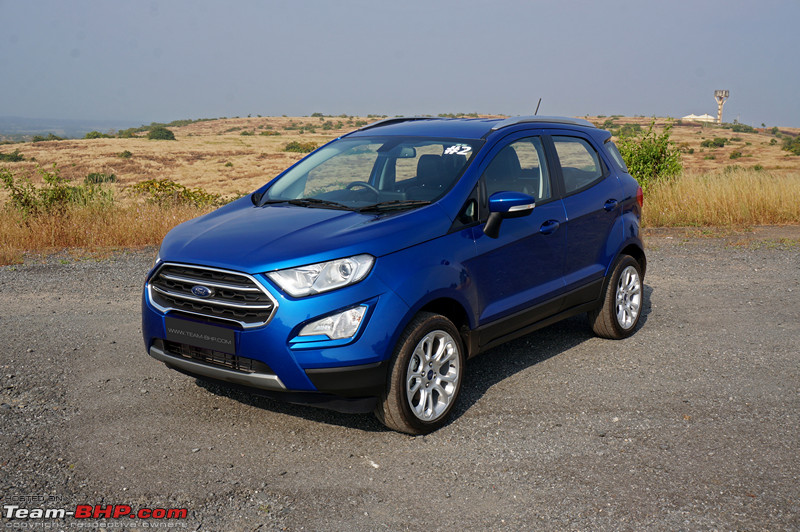 Back in 2013, the crossover space in India was just starting to boom. Other than the ubiquitous Safari and Scorpio, the Duster was making hay while the sun shone. It was the only crossover at the time that had car-like dynamics and was the perfect size for the urban commute. When Ford brought the EcoSport, they managed to get a huge one up over Renault by keeping the EcoSport's length under 4m. Ford pretty much opened up a new segment in India with their crossover. The only competition in this segment was the Mahindra Quanto, and we all know how that fared in sales numbers (read = flop). Thanks to a lower rate of excise duty levied on sub-4m vehicles, these compact SUVs were priced more competitively. Coupled with its car-like dynamics and SUVish looks, which Indians love, the EcoSport gained massive popularity, becoming the quintessential urban SUV. For nearly 2 years, the EcoSport was the only one of its kind in India. Ford cashed in on that popularity with continuous price increases, and even deleting equipment (much to the ire of its customers). Ford recorded 30,000 bookings for the car in just 17 days. The delivery periods stretched so long that Ford had to stop accepting bookings after the number crossed 60,000. By August 2014, the company had sold more than 1 lakh units of the EcoSport (60,000 in the domestic market and 40,000 in export markets). With production constraints, Ford could not keep up with the demand. Such was the popularity of the car. Waiting periods were well above 6 months for diesel variants. It was only in 2015 when the next wave of crossovers like the S-Cross & Creta came along that Ford started to see some competition. But it was in 2016 that Ford really began to feel the heat. Maruti brought in the Vitara Brezza and targeted the EcoSport head on. Sure enough, the Brezza took over Ford's crown and was the market leader almost immediately. We had barely returned from the Vitara Brezza's media drive when we heard that Ford slashed the EcoSport's prices! Ever since then, other manufacturers have jumped onto this bandwagon. Earlier this year, Honda and Tata introduced the WR-V and Nexon, respectively. Pretty much all these mini-SUVs have gone on to register respectable sales figures over the past few months.  Speaking of respectable sales, Ford has managed to sell an average of 4,000 copies of the EcoSport every month consistently. It's also the only mass market vehicle in its stable that has been selling in healthy numbers. Says a lot about the competence levels of the product. Still, the 4-year old EcoSport was beginning to show its age. The mild facelift in 2015 did help, but what was needed was a proper refresh. Even the early 2017 addition of a touchscreen infotainment system was a complete jugaad and looked like an act of desperation till they could get a full refresh. Ford hasn't disappointed and has gotten a properly refreshed EcoSport - inside out. Not only has Ford given the EcoSport a nip and tuck on the outside, but even the interiors are newer. What's more is that the changes aren't just cosmetic and skin deep. Ford have gone the whole hog and brought in a new petrol engine with a new 6-speed automatic transmission. The new 1.5L, 3-cylinder petrol engine (codenamed Dragon) is available with a 5-speed MT or a 6-speed torque converter AT (with paddle shifters). This new 1.5L 3 pot motor replaces the older 1.0L EcoBoost engine as well as the 4 banger 1.5L Ti-VCT. On the other hand, the 1.5L TDCi diesel powertrain remains the same as before. In all, Ford claims to have made over 1,600 changes to the car. Safety features such as 6 airbags on the top variant, ABS + EBD and reverse parking sensors have been retained, while a reversing camera and the Ford MyKey function have been added. Besides, the hill start assist and ESP / TC, which were previously available only on the petrol automatic, now come to the diesel as well. So, what's new on the outside? Front end gets a bold new grille which gives the EcoSport a more mainstream "Ford SUV" look. Headlamps and bumper are new too. This 'Lightning Blue' metallic shade has just been introduced. Overall, the car appears less funky and more mature compared to the old model. The design has matured vs the "in your face" front end of the earlier car:  To the layman, the rear will look identical to the outgoing car. Only BHPians will notice the minor changes to the bumper and rear wiper: 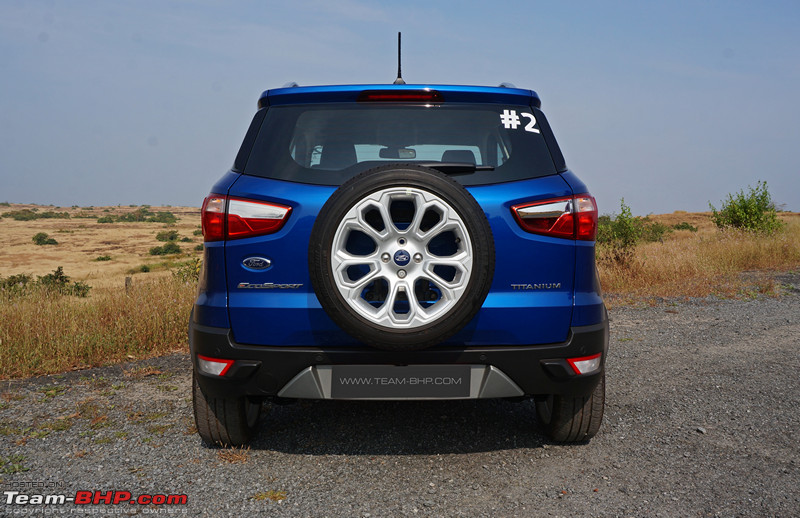 Except for the new alloy wheels, there are no changes to the side profile. At 3,998 mm and 2,519 mm, the overall length and wheelbase have been reduced by 1 mm (we find the wheelbase change weird):  Headlamp clusters contain halogen projectors for the low beam, a traditional halogen high beam and LED daytime running lights. Headlights are automatic, and get the follow-me-home function (where they stay on for a while after the car has been switched off). The headlight switch should be in the "Auto" position for the function to work:  Headlamps do not stretch as far back as we have seen in some newer cars: 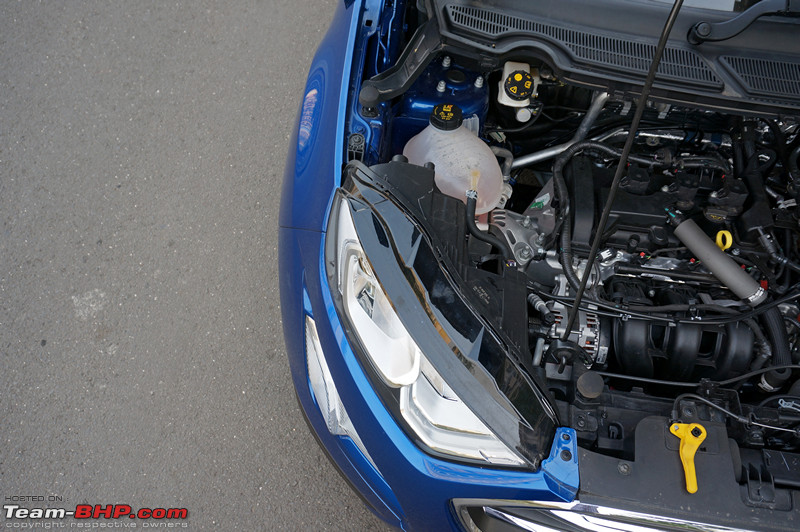 Turn-indicators are no longer housed in the headlamp clusters. They are replaced by reflectors. Click on image & notice the tiny Ford logo at the base!  DRLs come on every time the driver's door is opened. They double up as parking lamps; switching on the headlamps makes them dim a little:  With all the lights in action: 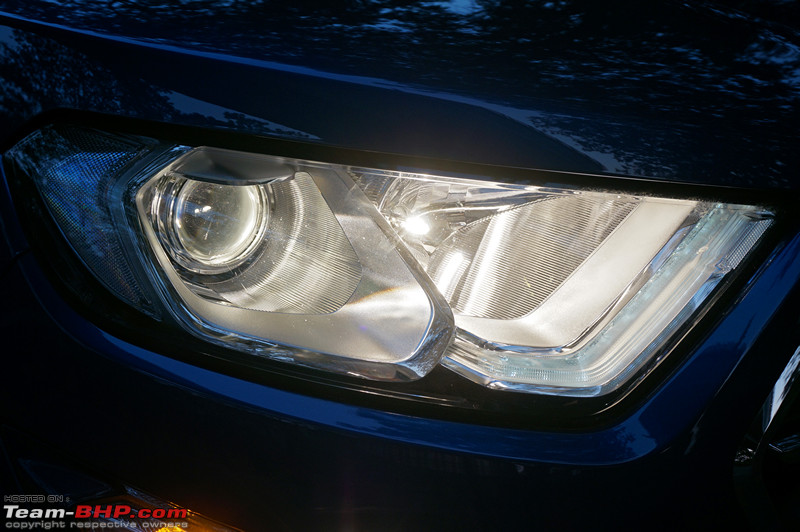 DRLs are bright and prominent, even during the day:  Large trapezoidal grille with a black mesh, chrome border, two chrome horizontal slats & the blue oval in between give the EcoSport improved road presence. Notice how the chrome border rises just above the number plate:  Bumper houses a wide, black air-dam with a few thin horizontal slats. Use of chrome is limited to the grille. That's just the way we like it: 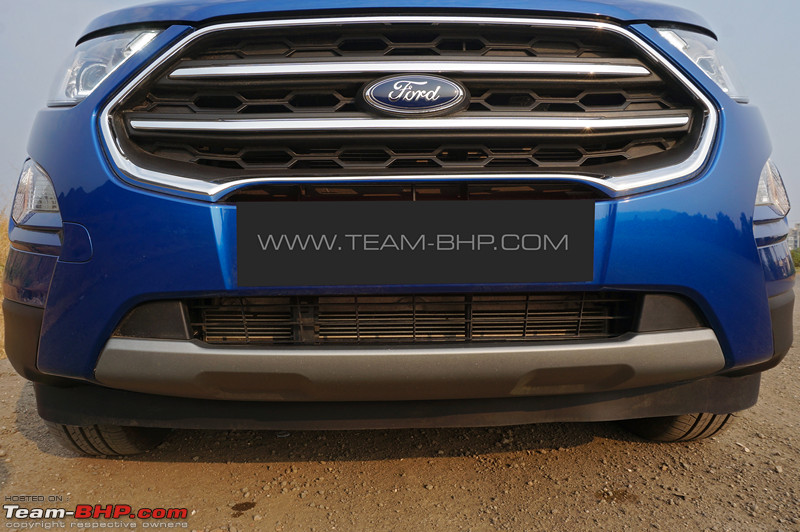 New, big foglamps. Turn-indicators have been moved from the headlamps to the foglamp clusters:  Notice how the foglamps are designed to stick out sharply:  With the foglamp and turn-indicator in action:  The old car's round tow hook cap has been replaced by something more fitting to the sharper design:  Silver plastic skid plate adds to the SUV look, but it is obviously not functional (was earlier available as a dealer accessory). There is no underbody protection. A wind deflector has been provided. Unladen ground clearance of 200 mm is unchanged:  Bonnet features a wider central dome adding a more muscular appearance:  No ugly windshield washers sticking out on top of the bonnet. Thank God!! They are now hidden neatly under the bonnet:  Washers squirt out effective sprays (rather than jets) of water. The wipers have a good sweep. Titanium+ variant gets auto wipers, while all variants get the courtesy (anti-drip) wipe feature:  ORVMs are now auto-folding. They house useful puddle lamps underneath:  While the design of the body-coloured door handles is unchanged, the black request sensors are gone... 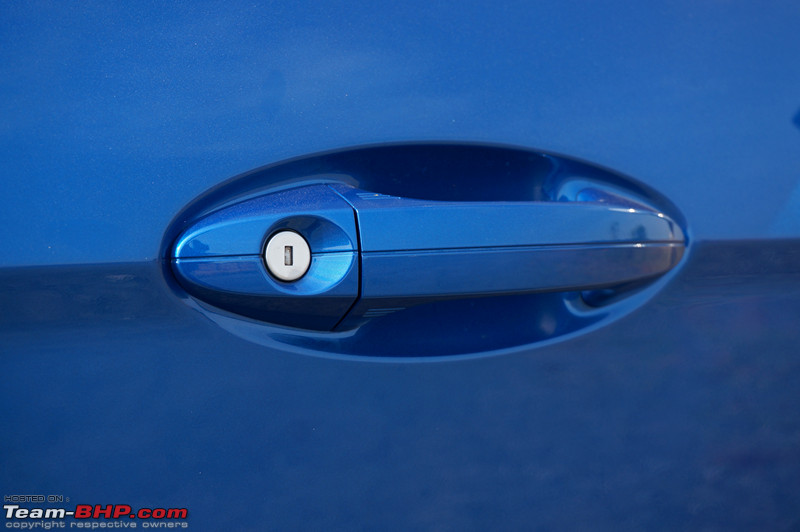 ...Sensors are now placed on the inside surface of the door handle. Simply walk up to the car with the keyfob in your pocket, grab the door handle and open the door. On doing this, the ORVMs fold out automatically as well:  To lock the car, simply touch this sensor located on top of the door handle (those three lines). The ORVMs will fold in automatically too:  Titanium+ variant gets new 17-inch alloy wheels shod with 205/50 section rubber. While the 17 inchers look fab, they are impractical for India (stiffer ride, wheel more prone to damage, costlier tyre replacements). We don't agree with this upsize. Ford has opted for Bridgestone Ecopia tyres, which are fuel efficiency oriented. That said, the grip on offer is sufficient. Ford also claims to have softened the suspension to compensate for the lower tyre profile (note = ride quality still isn't plush). Lower variants come with 15-inch steel wheels & 195/65 section tyres (Ambient & Trend), 16-inch steel wheels (Trend+) or 16-inch alloy wheels (Titanium) & 205/60 section rubber. All of the lower variants will offer better ride comfort due to the enhanced tyre sidewall height: 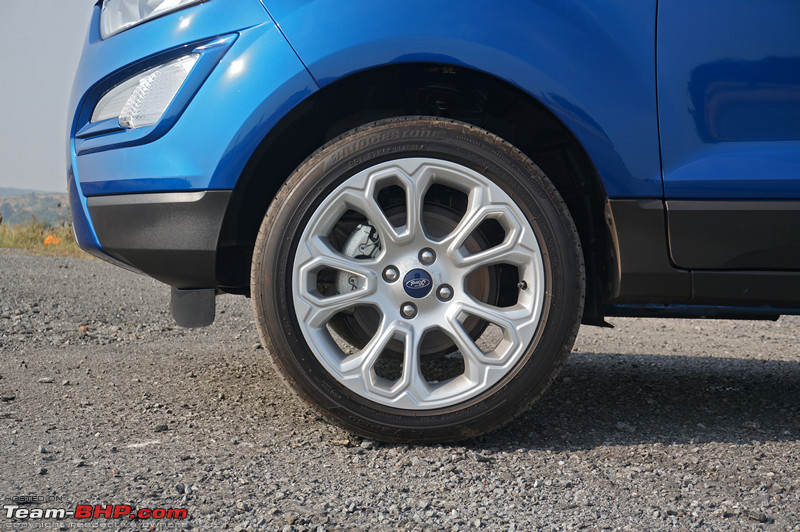 Titanium variant gets 16-inch alloy wheels with MRF ZV2K 205/60 section tyres. Grip levels are acceptable and the ride is marginally better than the Titanium+:  Small mud-flaps located ahead of the rear tyres are gone (2013 EcoSport had them - reference image):  Stubby antenna sits at the rear of the roof. It replaces the long old-school unit, which was mounted at the front of the roof:  Electromagnetic tailgate release is no longer housed on the chrome portion of the right tail-lamp:  Instead, it is now neatly concealed under the chrome insert. This was done in the 2015 update itself: 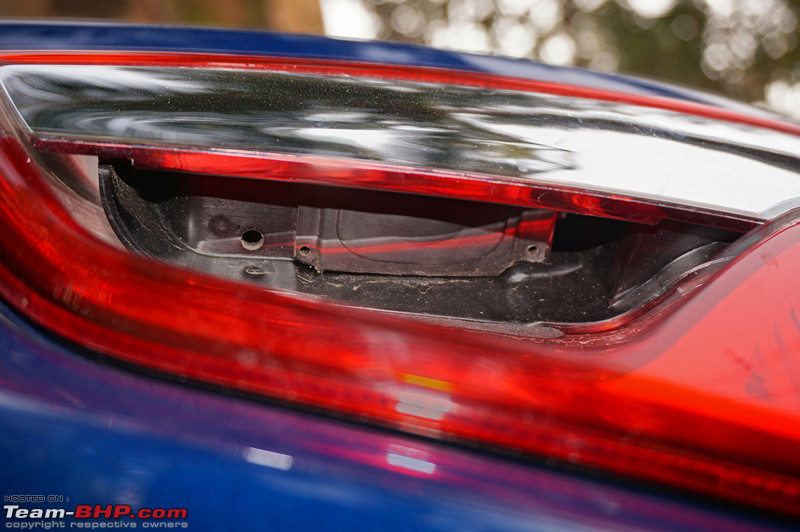 Rear wiper is frameless. Looks far better than the old car's traditional one:  Rear bumper is identical in design to the outgoing car's. The only difference is the silver insert in the lower part of the bumper:  Reversing camera is standard on the Titanium+ variant. It sits on the upper edge of the number plate housing. While it is neatly integrated, the camera is placed too low for my liking: 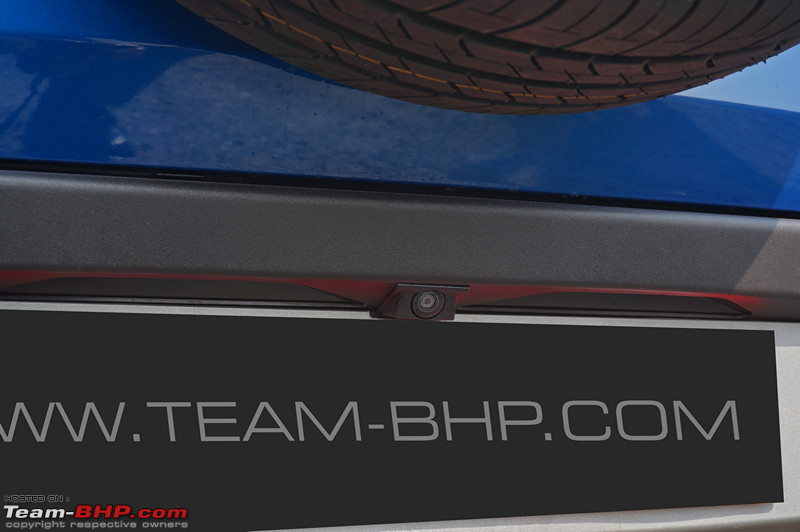 Silver insert serves as the number plate housing and helps break the bulk of the black bumper (was sold as an accessory before). Its colour matches the skid plate at the front: 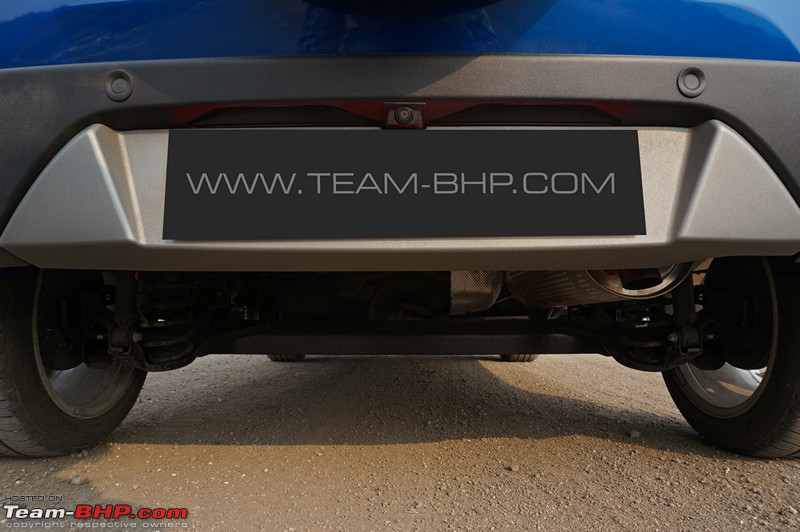 Rear foglamps, which were introduced in 2015, have been dropped with this facelift. Considering the growing stress on safety and the fact that rivals such as the Tata Nexon get one, this feature should have been retained. But then, less than 1% of Indian drivers actually know how & when to use the rear foglamps:  Alongside the BOSS of the segment:  Internationally, the facelifted Ecosport lost the tailgate-mounted spare wheel. However, in India, we love the butch SUV look it gave to the Ecosport and it surely was a standout feature. We're glad it's retained for India: 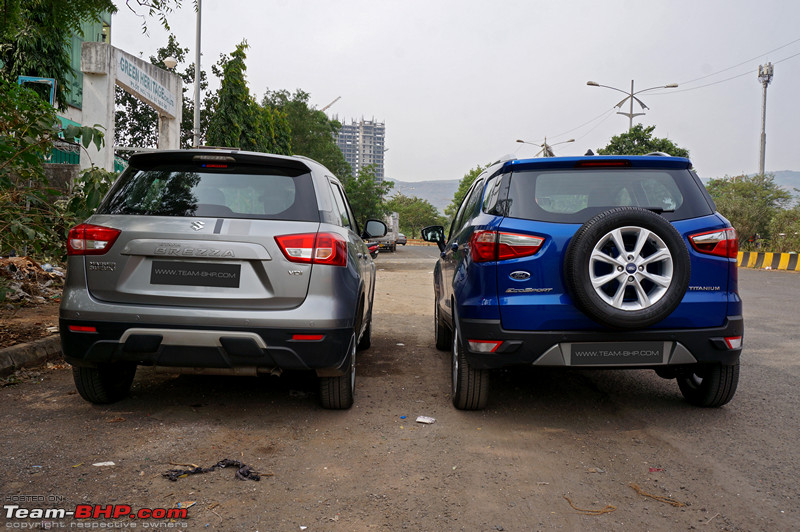 While the Vitara Brezza is the newer car, it's the EcoSport that manages to look more contemporary, no? 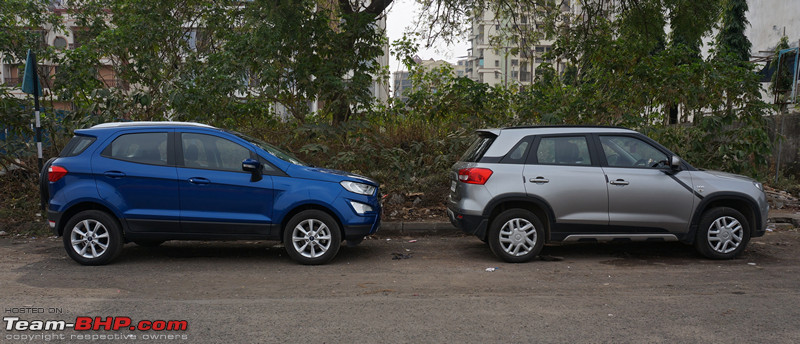 Last edited by Aditya : 5th February 2018 at 08:07. |
| |  (82)
Thanks (82)
Thanks
 |
| The following 82 BHPians Thank Aditya for this useful post: | 2himanshu, 400notout, aabhimanyu04, aeroamit, AkMar, aniket17, Anupam1024, AShubrah, asingh1977, Avikbrio, BigBrad, BoneCollector, CarguyNish, chiefpk, chinmaypillay, chiranjitp, Chrome6Boy, Col Mehta, darklord, deetjohn, Dr.AD, dZired, espraveen, FueledbyFury, GTO, IcarusMan, InControl, Jaggu, jithin23, Johnnny, Karthik Chandra, Keynote, lamborghini, lemedico, Leoshashi, libranof1987, MSAneesh, N33raj, naveen.raju, noopster, Obi-Wan, Omkar, pankaj_sachdeva, paragsachania, phoenixash, PrasunBannerjee, Punatic, R-Six, RaghuVis, RavenAvi, ravib, roby_dk, rpunwani, sainyamk95, samabhi, samaspire, searacer932, shipnil, siddarthab, Simhi, smuniswami, sngautam, sparky@home, strawhat, streetfighter, Suchu90, suku_patel_22, sunny29584, swiftnfurious, theexperthand, timussharma, Torino, Turbanator, TusharK, uday.ere, vaasu, vaish9925, Varun_HexaGuy, vb-saan, Vik0728, vredesbyrd, X_T_A Rose |
| | #4 |
| Team-BHP Support  | So, what's new on the inside? Like the exterior, the interiors of the EcoSport have been refreshed. The interiors have an all-black theme vs the black and grey earlier. The dashboard has been completely redesigned with a new steering wheel, switchgear and instrument cluster. The all-black interiors look good, but they make the cabin feel less airy than before. Definitely not a good thing as the EcoSport's cabin is anyway not too spacious. There are some silver and piano black bits that liven up the all-black cabin. Ford have loaded the interior with every single feature you can think of, such as ambient lighting, auto headlamps, auto wipers, auto dimming IRVM and a huge 8-inch touchscreen infotainment system with Ford's SYNC 3 software that supports Wi-Fi, Android Auto and Apple CarPlay. Overall, the dashboard is certainly more modern-looking than the outgoing car's. New black dashboard is functional and very well put together, but has hard plastics all over. Fit & finish is good in most places, although there are a handful of rough edges that feel out of place at this price point. Most of the switchgear is new vs the old car (some knobs and buttons like the climate control are lifted from the Figo / Aspire). The overall dash design looks classy and nowhere near as funky as the earlier one. It's no Hyundai in terms of quality, but there's lesser reason to complain than before. Ergonomically, the cabin is well laid out and all controls are easy to reach + operate: 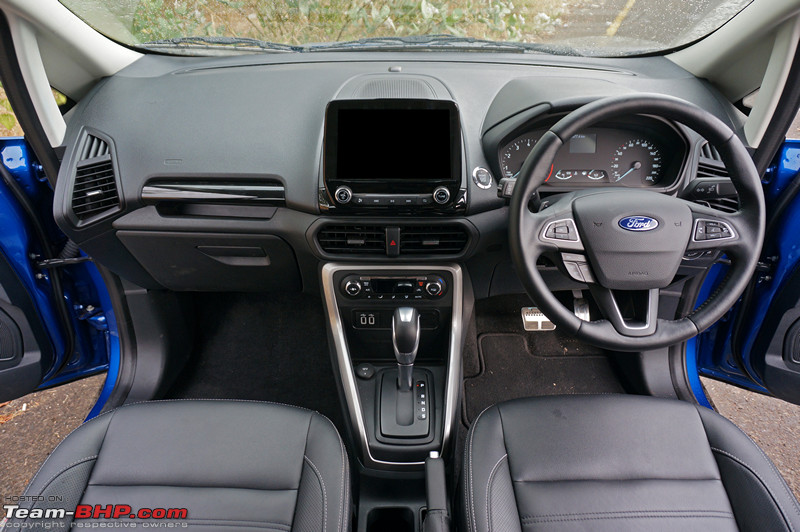 All new leather-wrapped steering wheel feels way more premium than the earlier one. The buttons, horn pad and leather wrap are of excellent quality. The wheel is chunky and a delight to grip, with contours for your fingers. Hornpad will be a stretch for those with small hands. It's not easy to press either:  Left spoke houses the buttons to toggle between the MID's features, while buttons for the audio controls, voice commands and telephone are located on the right spoke. No mute button provided. Silver borders around the buttons look classy:  Switches for the cruise control are located below the left spoke of the steering wheel. The system has an adjustable speed limiter. All together, this steering sure has an excessive number of buttons!  Zooming in to show you the stitching pattern on the steering. No contrast effect here:  Paddle shifters on either side of the steering in black - one on the left is for shifting down and vice versa. While the transmission responds to shifts quickly, the paddles don't feel meaty, and have a clicky feel:  Paddles are flat with no contouring, but they do have 3 ridges for grip:  Thankfully, the tilt and telescopic steering is retained. Much needed feature that many cars in higher segments are leaving out. Want proof? The Endeavour doesn't get it!!!  Concave engine start / stop button is also changed. It has a thick chrome border and a green light. Pressing the start / stop button once without pressing the clutch (brake in the AT) makes the green light blink continuously. When the engine is running, the light stays on:  Large & blank plastic piece covers up the place where the ignition key slot of the lower variants will be. Looks ugly:  Cheap looking instrument cluster is new. While the lettering is backlit in white, the needles are backlit in blue. An analogue temperature gauge has been provided  . While the instrument cluster is clear and easy to read, the MID is too small for our liking and the empty space around the MID makes it look worse. Readouts are in white instead of blue: . While the instrument cluster is clear and easy to read, the MID is too small for our liking and the empty space around the MID makes it look worse. Readouts are in white instead of blue: The diesel gets a different cluster, obviously with a lower redline. Also note that unlike international variants, the Indian spec cluster loses the chrome rings around the speedo + tacho making it look really low rent. That small MID is from the 90's. Come on Ford! The overall look doesn't suit the EcoSport's positioning & image at all:  Yikes! This interface, fonts & styling are a throwback to the 90's - did Ford pick them up from the Ikon? MID can be toggled between the trip meter, trip timer, average fuel consumption, average speed, distance-to-empty, real-time fuel economy (older FE bar was easier to read on the go than the constantly changing number), digital speedometer and tyre pressure monitoring system (TPMS). Outside temperature is displayed on the top right corner:  Settings that can be altered include the brightness of the cluster, language and the units of measurement (Celsius / Fahrenheit, miles / km, etc). One can toggle between the two trip meters and choose what data should be displayed from the ones mentioned in the previous image. In the AT, the different gear positions are displayed in the MID, with the selected gear being highlighted:  Parameters that can be changed include switching on / off chimes, auto engine off function, timing of the follow-me-home lights, functioning of the locking & unlocking of the doors, wipers and turning on / off the auto-folding function of the ORVMs. Guess what the 'Automatic Engine Idle Shutdown' (AEIS) is for? Nope, it's not the idling start / stop system seen in Marutis, Mahindras etc. Believe it or not, this one shuts down the engine if it is left to idle for a period of 30 minutes. Which private car owner is going to idle his car for 30 minutes, at least unintentionally (I'm looking at you, college-going kid  )? This feature is even more stupid than the idling start / stop system that we see & hate in other cars: )? This feature is even more stupid than the idling start / stop system that we see & hate in other cars: One can switch the driver assist features on or off through the MID. The cruise control operations are displayed as well, while clicking on the maintenance option takes you to the TPMS display: 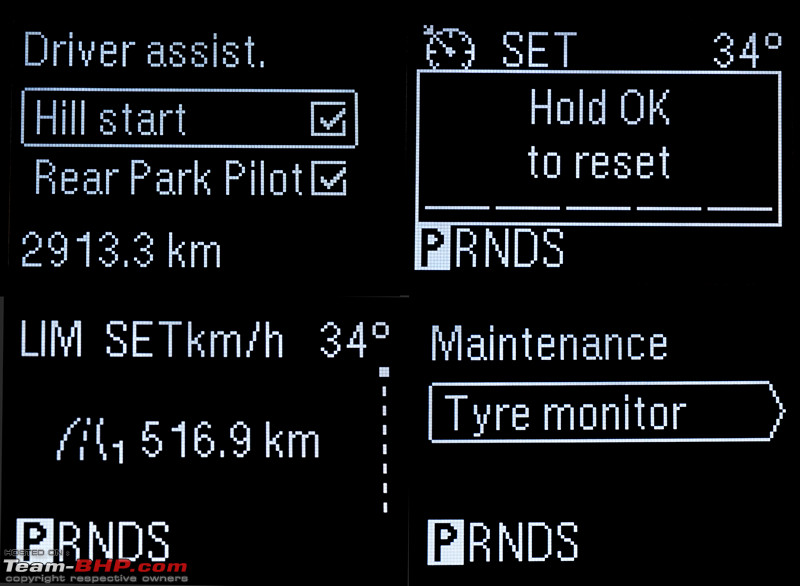 MID points out the specific door that is open. It also tells you if the tailgate is not closed properly, but there is no such warning for the bonnet. Pressing the start / stop button without pressing the clutch (brake in the AT) sends the car in "accessory" mode. Every time the driver's door is opened, the MID displays the odometer:  As we have seen in recent Ford cars, control stalks have finally moved over to the RHD configuration. Pull the right stalk to flash, push to toggle between the high & low beam. Switch on the outer edge of the left stalk is used to operate the rear wiper, while the inset switch is used to control the intermittent speed of the front wipers. Yep, that "A" denotes automatic wiper mode:  Side air-con vents get a black border in place of silver. Even with the vent shut, there is some air coming out of them:  Classy rotary knob for the headlamps replaces the older regulator-type knob. These are similar to the Aspire / Figo. Has 'automatic' headlamps. The headlamp leveler is inset in the rotary dial. Buttons for the foglamps and dashboard illumination are on either side. Superb integration & design:  Small cubby below the Euro headlamp switch to place odd items. It has a short lip:  OBD port is black, instead of the white unit seen in the old car:  Doorpads are identical in design to the old car's. The colour is darker though and the switches for the ORVMs & central locking system are new; their locations have changed too. The power window console has been tweaked. Disappointingly, the door pads flex when windows are lowered or raised:  Switch to operate the electric ORVMs is no longer located next to the door handle. It is replaced by Endeavour-style buttons for the central locking. Both the front doors get these (the door lock / unlock button was earlier on the centre console). Speed sensitive locking is no longer available though! However, Ford has added the mislock function where the horn will sound if one door is not properly shut and you try to lock the car. Additionally, the EcoSport comes with a crash unlocking function, where the car unlocks itself in the event of an accident (hazard lights flash as well). Earlier only the Titanium AT had tweeters, but now even the Titanium+ gets them on the front doors:  Power window console loses its border. The buttons have been rearranged and are now closer within reach of the driver. In the older car, the front window switches were too far away and you would inadvertently roll down the rear windows by mistake. One-touch up and down functionality has been provided for the driver's window only. Controls for the ORVMs are placed just ahead. The new buttons with the chrome tips look and feel way more upmarket. Even the new ORVM buttons look premium vs the old knob. Tiny lights have been provided to indicate which mirror has been selected for adjustment. The window lock switch has also been neatly integrated in the ORVM console:  Titanium+ variant gets leather upholstery with new white stitching (vs the older red). While they are very supportive for average built folks, those with a heavy build will find the seats a size too small (especially under thigh and side support). You don't sink into the seats, but sit atop them. Lumbar adjustment, which was present in the old car, has been deleted! Those with a delicate back will miss it. Still, thanks to a multitude of adjustments & the perfect ergonomics, finding a comfortable driving position is easy:  A look at the fabric upholstered seats of the Titanium variant:  Levers for adjusting the seat recline angle and height are redesigned. They look robust and feel sturdy: 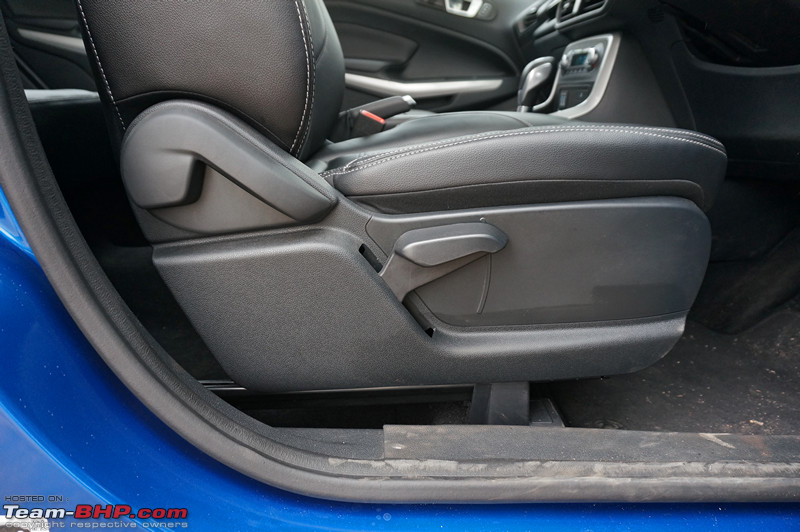 The fore & aft travel range is long. Even tall drivers will fit in without complaint: 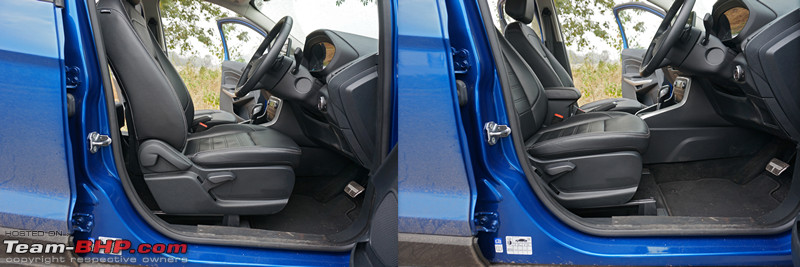 A look at the seat in the lowest and highest positions. Adjustment range is healthy. Headroom is excellent. At 5'10", I still had ample headroom, with the seat in its highest position:  No lumbar adjustment anymore which is why you don't see the knob here. You win some, you lose some. This was a very useful feature of the older car. We hate it when manufacturers take away stuff they once offered (in recent times, Hyundai has also been guilty of that):  New center armrest has a soft surface. Sadly, it is not adjustable & will thus never be used by shorter drivers (who take the seat ahead). The 2013 EcoSport had a far superior solution as the armrest was attached to the seat and would therefore move front & back with it:  A closeup of the leather upholstery. Quality is acceptable for a car of this price:  A close look at the fabric upholstery pattern of the lesser variants:  Front seats in the Titanium & lower variants get a sturdy metal lever for fore & aft adjustment (unlike what you saw in the Titanium+ above):  Both front seats are lined with carpeting on the inner sides to hide the ugly bits:  The footwell is wide enough and a useful dead pedal is provided! All pedals are finished in aluminium, with the clutch and brake pedals getting black rubber on the surface. Dead pedal is long & well-positioned:  A look at the automatic's footwell. Dead pedal could've been wider as there is room. Titanium and Titanium+ variants get multi-colour footwell lighting:  Titanium+ variant gets an auto-dimming IRVM. It is wide enough to cover the entire rear windshield. Thick C-pillars and headrests do hamper visibility though:  Sensor for the auto-dimming function is located behind the IRVM. Feature is on by default; you don't even have to press any 'auto' button:  Center fascia features a touchscreen that sticks out from the top of the dashboard a first for a Ford car in India. Piano black has been used around it and there is a thick silver border running around the lower part of the center fascia - from the climate control system to the gear console. Chrome highlights have been used at various others places as well:  More modern climate control sensor looks far better integrated in the dash (check older one here):  Center speaker sits on top of the dashboard. Some people mistakenly thought that its a subwoofer here - nope. No manufacturer would place a subwoofer here as it would lead to dashboard rattles on the 2nd day of ownership: 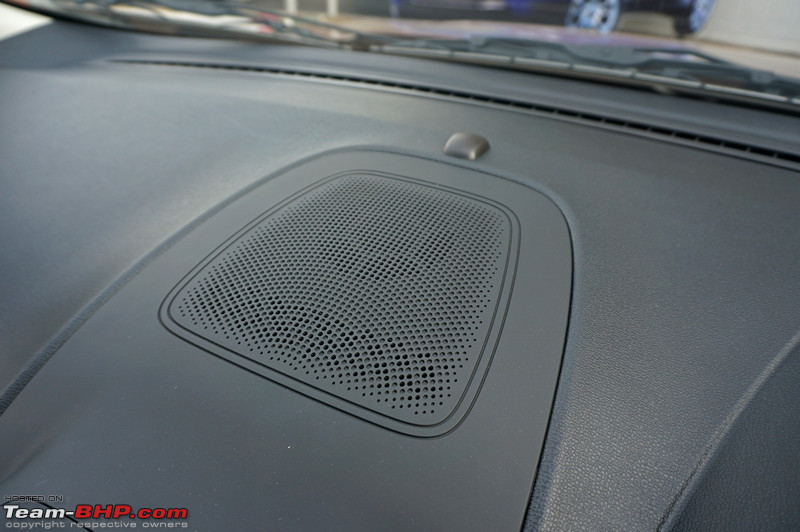 Tablet-like 8-inch touchscreen infotainment system is standard on the Titanium and Titanium+ trim levels. This is one amazing head-unit. It's covered in detail in a separate post:  See how the touchscreen sticks out from the top of the dashboard:  Central air-con vents now move lower down to make way for the touchscreen. The air direction controllers have chrome inserts. Air flow volume cannot be adjusted or turned off (unlike the older car):  Climate control console is identical to the one in the new Figo. It is super easy to use and the A/C is impressively powerful. The buttons are on the smaller side though. Chrome dials with a knurled finish (for the temperature & blower speed) look premium. The blower has 7 levels of adjustment. At levels 1 and 2, it is silent. At levels 3 and 4, it gets audible. At levels 5 and 6, it is loud, while on level 7, the noise is excessive. The lowest temperature that the system goes to is 15.5 degrees centigrade before hitting 'LO', while the highest temperature level is 29.5 degrees before hitting 'HI':  A couple of illuminated USB ports are located below the climate control system. No more fighting for the port between the driver & passenger. Both ports allow you to connect your smartphone to the infotainment system and serve as charging points:  Traction control is available in the Trend+ variant of the Petrol AT and Titanium+ variant of the Petrol AT & Diesel. It can be turned off via this button (not recommended in Indian driving conditions):  Other variants get a small cubby hole in its place:  Narrow storage space at the base of the center fascia has a rubberised base: 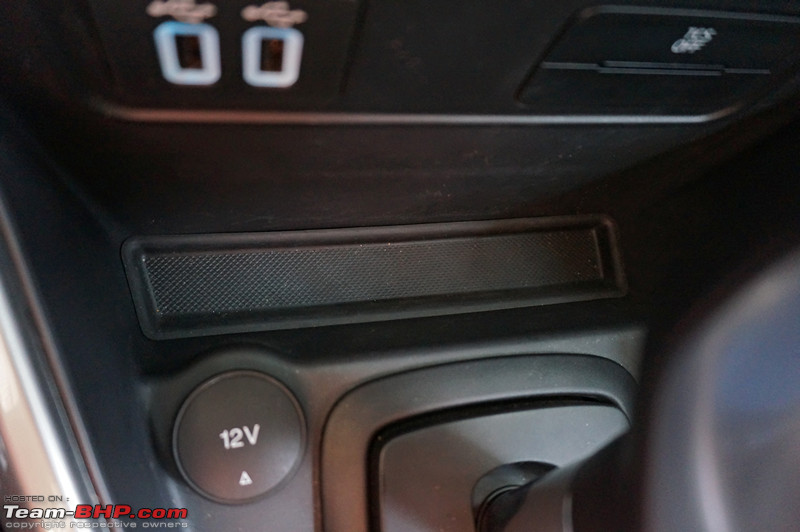 One can leave his 5.5-inch smartphone standing on its side while connected to the USB port (Ford says iPhone 7 Plus will easily fit here):  12V power outlet has a flip cover and is located at the top-left corner of the gear console (vs near the handbrake in the older car). The older location was better as you could hide the wires in between the seats: 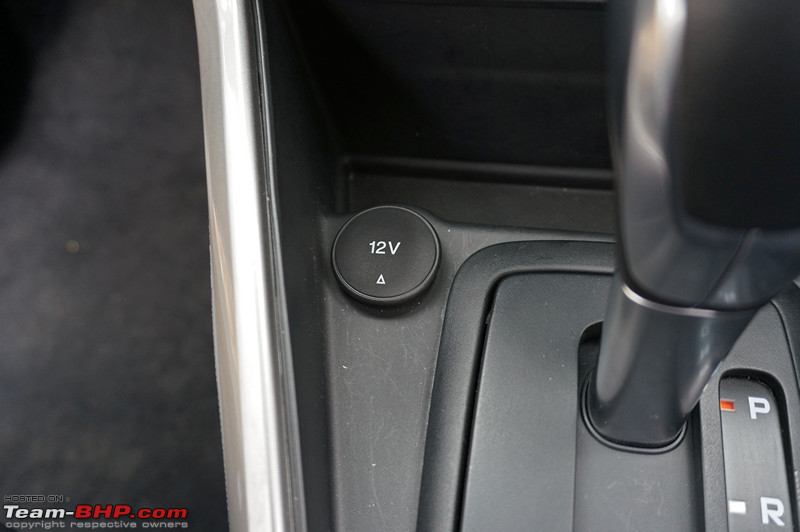 Center console houses a couple of cupholders, a square cubby hole behind them and a rectangular cubby hole ahead of the handbrake. You won't complain about lack of storage in this car (except the boot): 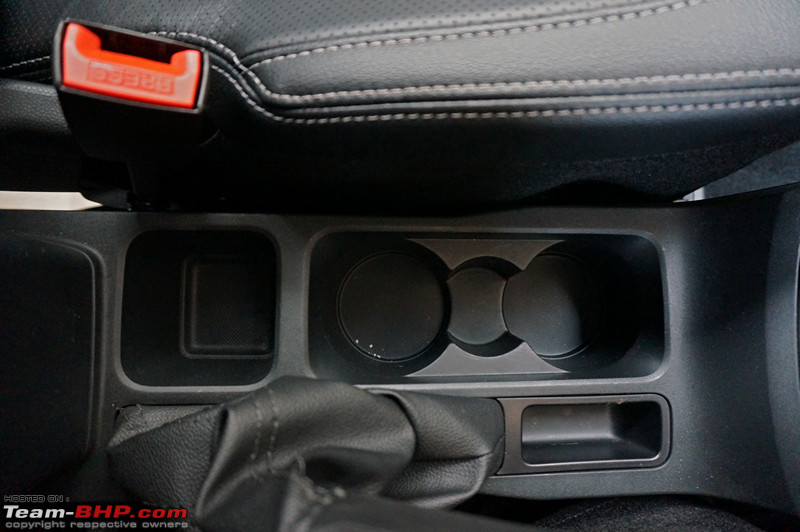 Handbrake moves from the left to the right of the center console. It has a leather boot:  Storage bin under the center armrest is deep and can swallow a 1L bottle!  Underside of the lid features a nifty pen holder:  Grab handle with a piano black insert keeps things from getting boring on the passenger's side of the dashboard. Slim storage space below the handle has a rubberised base:  Glovebox continues to have 2 compartments, but is slightly redesigned. Like before, it is not deep:  Unlike the old car, a useful light has been provided, but the cooling vent is gone! The lower edge of the upper compartment is sharp and can scratch your fingers while accessing things in the lower compartment:  Storage drawer under the front passenger seat is provided in the Titanium+ variant only:  It now has a removable rubberised lining:  Passenger side sunvisor now gets a flip cover for the vanity mirror:  While there are no loose wires dangling around, the plastics below in the passenger's footwell appear poorly finished. This is no Hyundai for sure:  Rear doorpads remain unchanged, except for the darker shade: 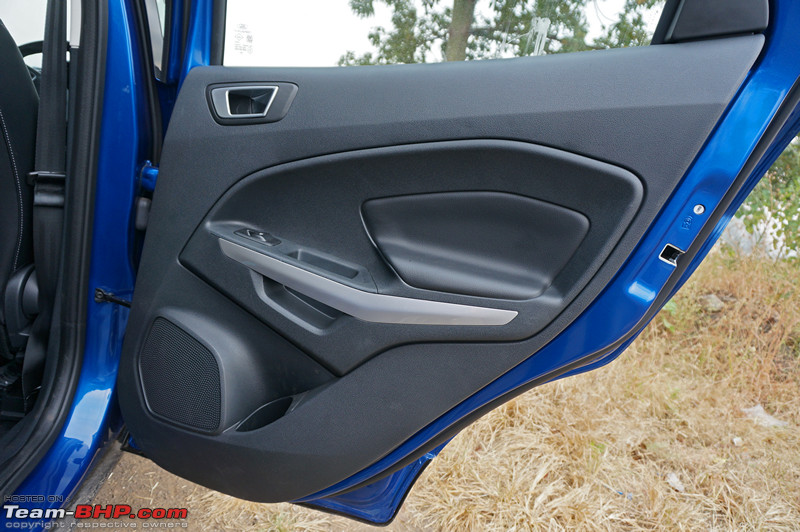 Ford have slightly redesigned the rear seat with more contours than the old car. While it can no longer be reclined, the recline angle of the seatback is comfortable. You can also see the new centre armrest for rear passengers. The width is still the same which means it's best for 2 at the back; 3 abreast will be intimate: 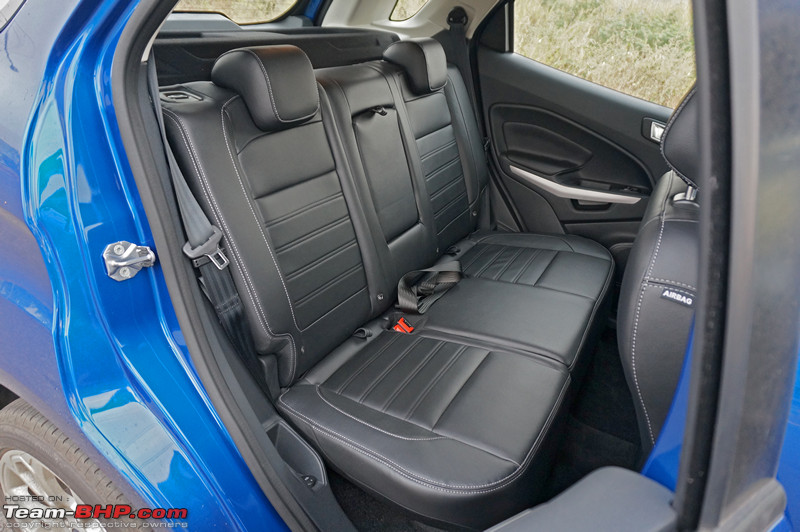 The seatbase is flat, yet the cushioning is adequate with decent underthigh support. The seatback has bolstering on the sides. Side passengers get 3-point seatbelts and adjustable headrests (three levels of adjustment). The middle passenger gets a lap belt only:  When not in use, the seatbelt buckles can be tucked away into cavities designed in the seatbase:  ISOFIX child-seat anchors are available only in the Titanium+ variant. They are present on both sides of the seat:  The seatbacks of the front seats are scooped out & soft, freeing a little more room for passengers. Both front seats come with seatback pockets for storing odd items. Thankfully, the metal bar that was seen at the bottom of the front seats of the old EcoSport (reference image) is not present in the facelift. This enables rear seat passengers to slide their feet under the front seat comfortably: 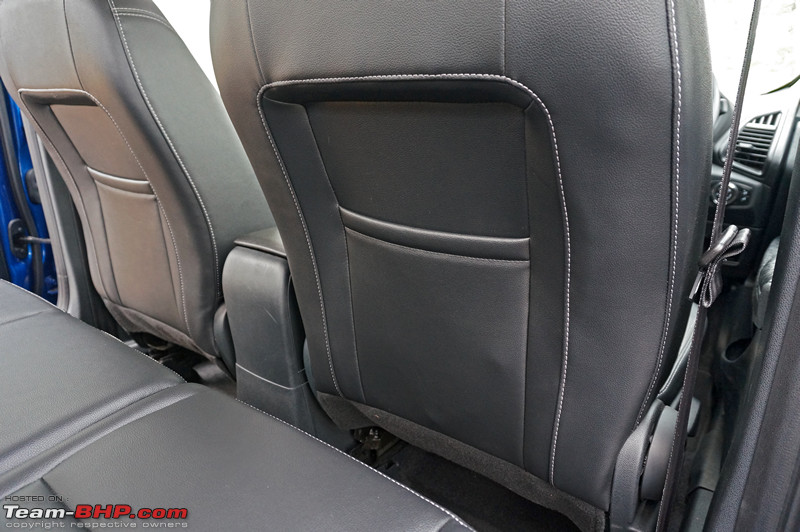 New center armrest with cup-holders:  It is wide enough and has satisfactory cushioning where occupants would place their elbows:  As mentioned earlier, Titanium and lower variants get fabric upholstery. While the seatback is split in a 60:40 ratio and adjustable headrests, seatbelts and center armrest have been provided, ISOFIX child seat anchors have been left out - a big miss considering even some hatchbacks (read Maruti Ignis) get them as standard across all variants. The seatbase cannot be tumbled forward either:  With the addition of the center armrest at the front, the bottle holder at the end of the center console has been left out. This unit also eats into knee space for the middle passenger (who isn't welcome anyway). No rear A/C vents here:  352-liter boot is enough to accommodate luggage for those weekend family trips. Bigger than the Nexon and Vitara Brezza, but smaller than the WR-V. Thanks to the split tail-lamps, the opening is wide:  Parcel tray is fixed vs the retractable one that was there in earlier models. This was done with the 2015 update. It is also short and not very accommodating:  Remember the ugly gap between the parcel tray and rear seat (see it here)? It's almost sealed in the 2017 facelift:  A look at the boot with the parcel tray in place. The luggage compartment floor is adjustable for 3 levels as well:  There is a visible difference between the 3 levels of adjustment. Here is how the boot looks with the floor at the highest level...  ...in the middle...  ...and at the lowest level:  Pull this strap to tumble the seatbase forward:  New, well-finished button to fold the seatback forward. Looks upmarket:  Selective folding if you need to carry a combination of cargo + passengers. Note the tumbling mechanism has now changed: 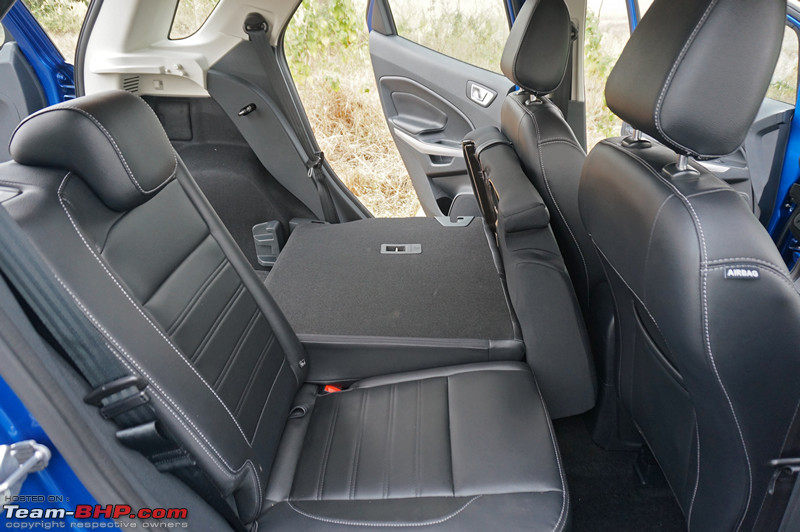 With both the rear seats folded forward, you get a whopping 1,178 liters of cargo space!  With the boot floor fitted in the highest slot, you get a perfectly flat loading bay now:  Titanium and lower variants do not get a height-adjustable boot floor:  Chunky, well-finished handle for lifting the boot floor replaces the strap in the outgoing EcoSport:  Top tether for the child seat:  Boot now gets these tiny storage boxes on either side...with removable flaps:  Last edited by GTO : 16th January 2018 at 11:36. |
| |  (54)
Thanks (54)
Thanks
 |
| The following 54 BHPians Thank Aditya for this useful post: | aabhimanyu04, aeroamit, anshuman1117, Anupam1024, arunphilip, AShubrah, Avikbrio, CarguyNish, chiranjitp, darklord, deetjohn, Dr.AD, espraveen, GTO, InControl, Jaggu, jithin23, Karthik Chandra, Keynote, lemedico, libranof1987, MSAneesh, myavu, N33raj, Obi-Wan, Paavan Shetty, paragsachania, phoenixash, Punatic, R-Six, RaghuVis, Rakshith220, RavenAvi, ravib, RGK, rpunwani, samabhi, samaspire, Simhi, sngautam, sparky@home, strawhat, suku_patel_22, sunny29584, swiftnfurious, tharian, theexperthand, uday.ere, vaish9925, Varun_HexaGuy, vb-saan, Vik0728, vnabhi, X_T_A Rose |
| | #5 |
| Team-BHP Support  | In-Car Entertainment The Titanium and Titanium+ variants of the Ford EcoSport get an 8-inch touchscreen infotainment system (Trend & Trend+ get a 6.5-inch touchscreen) with 7 speakers (including 2 tweeters & 1 center speaker). Connectivity is through Bluetooth and USB. Surprisingly, there is no Aux-in connection anymore. Apple CarPlay and Android Auto are supported (latter with navigation). The system features SYNC 3 with voice control, WiFi connectivity and serves as a screen for the reversing camera. To put it simply, this touchscreen is among the best we have used in mass market cars in the country. It is easily on par with what we see in cars costing 3 - 4 times as much. The unit has no lag and the visibility is good, even under direct sunlight. Screen resolution and clarity are brilliant. On the other hand, sound quality is ordinary and it's no match to the Tata Nexon. Physical buttons have been provided as well for those who prefer using them over a touch interface. The display can be switched off (for night driving) or brought back to life using the button in the bottom-right corner. Useful because the touchscreen's high position can be distracting on night highway drives. Don't miss the 'Compass' (pointless in a 2WD car):  Music is played through 7 speakers, including a central speaker on the dashboard, a speaker and tweeter on each of the front doors...  ...and a speaker on each of the rear doors:  The font size is large and easy to read. The time and outside temperature are displayed at the top of the screen, whereas the temperature of the climate control is seen on the top left. The WiFi signal strength is displayed on the top right corner:  Audio settings include the usual equaliser settings... 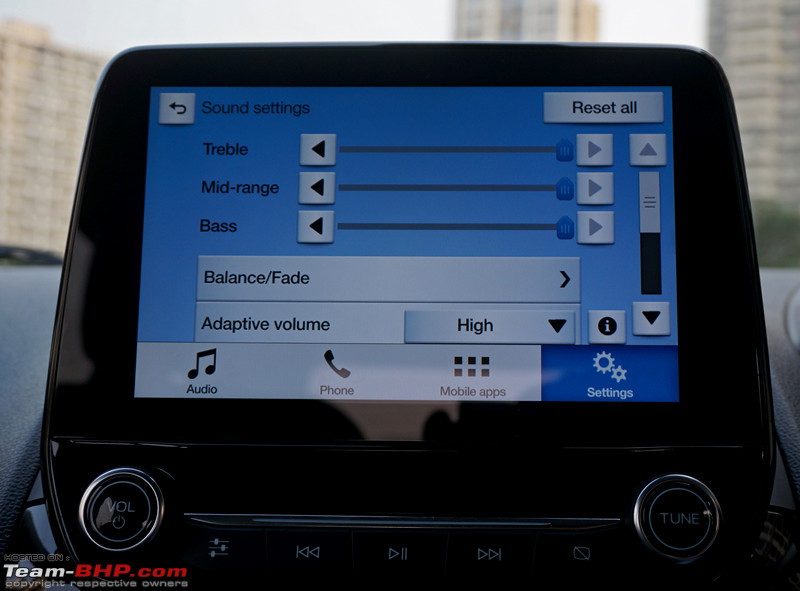 ...and fader / balance adjustments. The sound has a focus on mid to high frequencies, but lacks strong bass. While there is no distortion at higher volumes, the system is best played at moderate volumes. Audiophiles will be left wanting. Safe to say that the SQ is not as impressive as the touchscreen head unit:  The adaptive volume increases or decreases the volume according to the speed of the car, while the DSP Occupancy feature calibrates the sound to match the preferred listening areas in the car. You can choose between the driver's seat or all seats:  A variety of settings can be altered to suit the user's preferences:  By altering the general setting, you can change the language and unit of measure for the distance and temperature readouts. The display on the climate control system also changes accordingly! The beep-on-touch feature can be enabled or disabled from this screen:  Automatic system updates can be enabled or disabled and information about the SYNC system and software licences is provided. Factory settings can be restored through this screen as well:  The SYNC 3 system is Ford AppLink compatible. Certain apps installed on a connected smartphone can be accessed through the touchscreen & controlled through voice commands:  We LOVE Spotify & are delighted to see it here:  Apps include Hungama Drive, InShorts, Maps by MapMyIndia, AccuWeather & Pparke among others:  Has Ford's Emergency Assist System which will automatically call 108 (emergency services) in case of an accident (full details here):  A look at the screen in night (dimmed) mode:  Colour of the ambient lights in the footwells can be customised:  Bluetooth pairing is super easy. You can select which phone should be prioritized in connectivity: 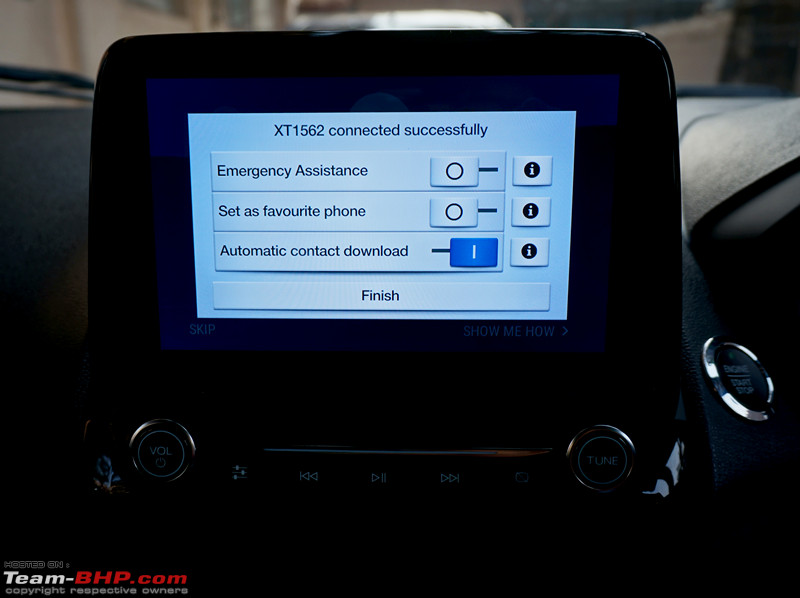 Lists include call history and contacts. Text messages can be displayed as well. The user can choose whether he wants to receive calls or not through the "Do not disturb" feature:  Phone clarity is good: 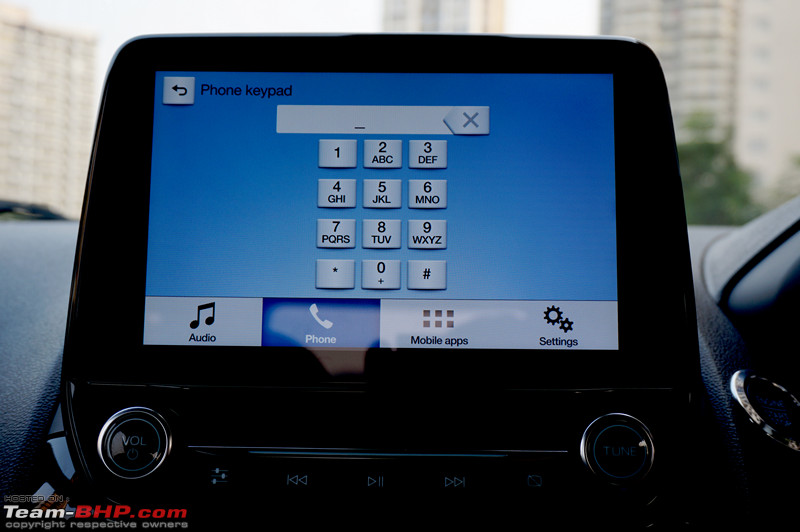 You can get a notification when your smartphone's battery is running out too!  You can even choose from 3 different ringtones for incoming calls: 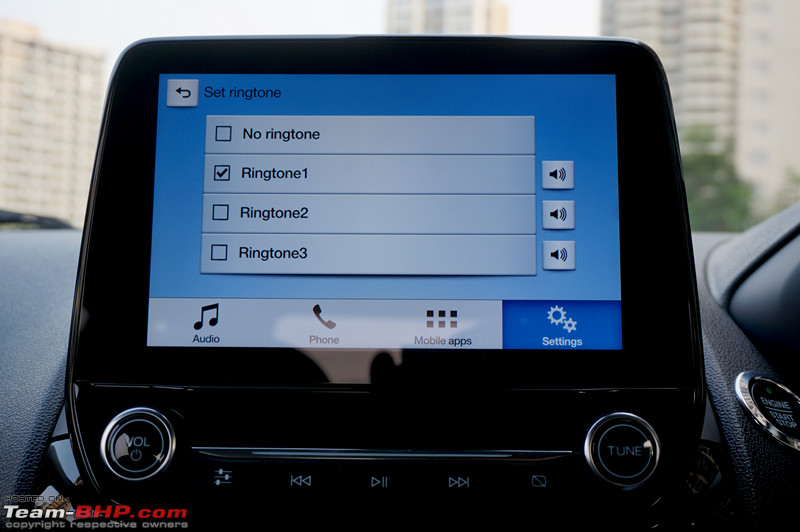 Choose a tone for incoming SMS:  One can have text messages read out by the system by enabling this feature:  Alternately, text messages can be viewed on the screen:  Every time the volume is changed, it is displayed on the infotainment system. Got to love the graphics!  A similar display appears with a change in blower speed...  ...or on altering the temperature of the climate control system:  You can connect the system to a nearby WiFi network (or your phone's WiFi via tethering):  The EcoSport gets Android Auto and Apple CarPlay as standard on all variants, except the base (Ambiente). To use Android Auto, owners have to connect their smartphones to the system via a USB cable. You can get directions, make calls, send and receive messages and listen to music through this Android interface:  Navigation via Google Maps is obviously superb. Android Auto helps in getting real-time traffic updates (via Google) on the screen:  The screen doubles up as a display for the reversing camera. It has adaptive guidelines too which gives you an indication of the vehicle's path with the steering wheel turned:  Rearward visibility remains a problem in the EcoSport. Therefore, along with the 4 parking sensors, the camera proves to be useful while reversing:  Uniquely, you can zoom in when maneuvering in tight situations!!!  In the dark, the display quality is easily on par with high-end German cars. Simply fantastic:  Valet mode lets you handover the vehicle to a driver without giving him access to the SYNC system:  Engaging and disengaging Valet mode is done via a 4-digit PIN:  Last edited by GTO : 16th January 2018 at 11:34. |
| |  (49)
Thanks (49)
Thanks
 |
| The following 49 BHPians Thank Aditya for this useful post: | aabhimanyu04, aeroamit, Anupam1024, AShubrah, Avikbrio, benbsb29, blurust, BoneCollector, Chrome6Boy, darklord, deetjohn, Dr.AD, GTO, InControl, Jaggu, jithin23, Karthik Chandra, Keynote, lemedico, libranof1987, MSAneesh, N33raj, Nohonking, Obi-Wan, Omkar, paragsachania, phoenixash, Punatic, R-Six, Rakshith220, RavenAvi, ravib, rpunwani, samabhi, Simhi, sparky@home, strawhat, streetfighter, suku_patel_22, sunny29584, swiftnfurious, theexperthand, uday.ere, vaasu, vaish9925, Varun_HexaGuy, vb-saan, Vignesh Vee, X_T_A Rose |
| | #6 |
| Team-BHP Support  | Technical Data on Ford's new Dragon Engine The most significant change to the EcoSport is the heart, with the introduction of a new petrol engine. Ford earlier had 2 petrol motors, a 1.5L, 4-cylinder Ti-VCT and the 1.0L, 3-cylinder EcoBoost. Both these engines were rather different in the way they performed. While the 1.0L was only good at higher revvs (suffered from lag at lower revvs), the 1.5L was a mediocre engine overall. The 1.5L also didn't benefit from excise savings as it was above the 1,200 cc limit. Though the 1.0L engine could benefit from the excise savings, it was a complex engine with a turbocharger and thus expensive. Ford is consolidating the petrol line-up and the result is this new 1.5L, 3-cylinder naturally aspirated mill codenamed "Dragon". The displacement is 1.5L, but with only 3 cylinders. It also loses the forced induction and doesn't get the excise benefits either. The 2017 EcoSport facelift becomes the first car in India to get an engine from the Dragon family. In the future, we will probably see the dragon engine makes its way into other Ford vehicles like the Figo & Aspire. Ford is building the new engine at its Sanand plant, which was inaugurated in March 2015. An excellent report of the engine and the various processes involved in building it has already been compiled by Moderator Bblost. Salient Features of the 1.5L Dragon: Fords second 3-cylinder petrol engine in India. The Dragon series engines have been developed with insights from the India engineering team. They were part of all stages - design, development and production. 80% of the parts for this new engine are sourced from Indian suppliers. India receives the 121 BHP and 150 Nm tune - the same as international markets such as Australia. The new 3-cylinder engine with an aluminium block is lighter, reduces friction and is 10% smaller in size. The engine is claimed to achieve a 7% decrease in Brake Specific Fuel Consumption (BSFC) & CO2 emissions. Twin independent Variable Camshaft Timing (Ti-VCT) is claimed to deliver faster throttle response and enhanced fuel economy. The Ti-VCT system allows each intake and exhaust cam to function independently of each other as the engine operating conditions change. Engine is paired to a 5-speed manual transmission or a 6-speed automatic. 3-cylinder engines are inherently imbalanced. The end result is a rocking motion as there is no opposing cylinder moving in the opposite direction (much like an unbalanced see-saw). Manufacturers usually cancel out this imbalance via a balancer shaft that has an uneven mass. It basically works like a counter weight or a mass damper to reduce vibrations & rocking motions by spinning in the opposite direction. Balancer shaft is supported by hydrodynamic bearings. Engines timing belt moves through oil to reduce friction and NVH levels when it is running. This also improves the life of the belt. Acoustic isolation system in place to prevent harsh engine sounds from entering the cabin. The Dragon series petrol engine for the new EcoSport is a 1.5 L, 3-cylinder naturally aspirated petrol which produces 121 BHP and 150 Nm of torque:    Sharing Ford's slides:   The cover is integrated with engine brackets in order to reduce the weight:  The crankshaft is offset from the vertical axis of the piston and cylinder. Generally, the offset crankshaft is placed such that during the power stroke, the crankshaft is almost perpendicular to the vertical axis and the connecting rod is co-linear with the vertical axis of the piston cylinder:  A balancer shaft helps in eliminating the first order vibrations which are commonly seen in inline 3-cylinder engines (related discussion):  Exhaust manifold is integrated with the cylinder head. Internationally, many automakers are moving to an integrated exhaust manifold (related link):  The valve actuation system is responsible for the closing & opening action of the valves. This particular system is claimed to self-regulate valve lash (the gap between the rocker arms and valve tappet):  Belt in oil has been implemented to reduce friction and noise:  Each cylinder gets a separate ignition coil. Benefit? Easier cold start and better combustion control. The spark plugs are placed at the center of the combustion chamber: 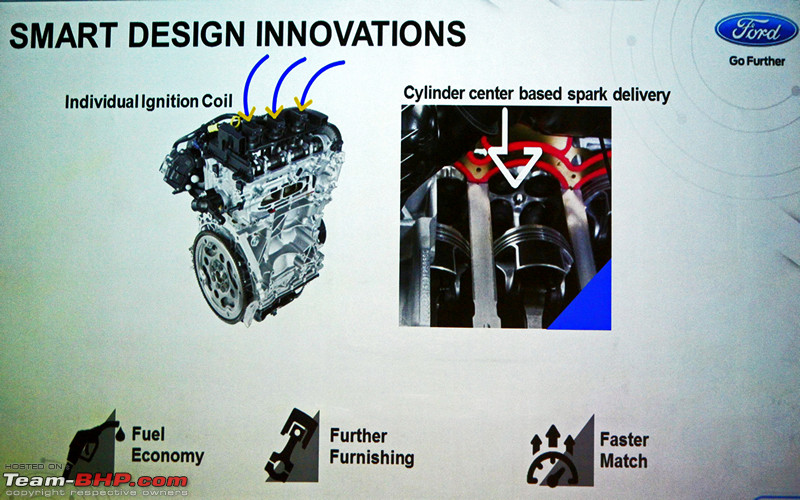 A summary of all the technologies used:  The power (kW) and torque (Nm) vs engine speed (rpm) graphs showing the comparison between the 2 engines - 1.5L 3-cylinder vs 1.5L 4-cylinder:   The aluminium block:    The balancer shaft on top:  The timing belt. You can notice the roller rocker and hydraulic touch, which was shown in the presentation deck. This makes the system compatible with alternate fuels like LPG and CNG. It helps reduce friction and needs no maintenance. Also seen here are the twin variable camshafts (Ford's Ti-VCT tech):  Last edited by GTO : 16th January 2018 at 11:33. |
| |  (47)
Thanks (47)
Thanks
 |
| The following 47 BHPians Thank Aditya for this useful post: | aabhimanyu04, aeroamit, anshuman1117, AShubrah, Avikbrio, Balaji31582, Col Mehta, deetjohn, espraveen, Grease_Monkey, GTO, InControl, Jaggu, Karthik Chandra, Keynote, lemedico, libranof1987, MSAneesh, murthy_p, N33raj, Nohonking, Obi-Wan, Omkar, paragsachania, phoenixash, Punatic, R-Six, Rakshith220, RavenAvi, ravib, rbvg@, rpunwani, samabhi, Scorpion 10, Simhi, smuniswami, sngautam, sparky@home, suku_patel_22, swiftnfurious, tharian, theexperthand, uday.ere, vaish9925, Varun_HexaGuy, vb-saan, X_T_A Rose |
| | #7 |
| Team-BHP Support  | Driving the 3-Cylinder 1.5L Petrol MT Thanks to the driveability on offer, new Dragon engine is clearly more convenient to live with than the older 1.0L EcoBoost & 1.5L units. Petrol customers will be happier. That said, the EcoSport's motor of choice remains the all-rounded 1.5L 4-cylinder diesel:  Among the ugliest, most cluttered engine bays we've seen on a modern car. Lack of engine cover makes it worse:  The EcoSport petrol gets a new 1,497cc, 3-cylinder naturally-aspirated motor under the hood. It produces a very healthy 121 BHP @ 6,500 rpm and 150 Nm @ 4,500 rpm. That torque figure falls short of the Tata Nexon's 170 Nm, although the horsepower rating puts the Ford ahead of all other compact SUVs. When compared to the earlier turbocharged 1.0L motor, it falls just 2 BHP short (torque difference is more though @ 20 Nm). The old 1.5L, 4-cylinder unit with 110 BHP & 140 Nm on tap has been comfortably overshadowed. With a hefty kerb weight of 1,220 kilos, the EcoSport is a whopping 133 kilos heavier than the Honda WR-V, yet lighter than the Nexon by 17 kilos. It has a power-to-weight ratio of 99 BHP / ton and torque-to-weight ratio of 123 Nm / ton. While the former puts the EcoSport ahead of all its main rivals, the latter is a little short of the Nexon’s 137 Nm / ton. To start the engine, you need to press the clutch and then hit the engine start / stop button. While the clutch pedal is light, we found its travel range to be longer than required. On startup (or when the engine is turned off), there is perceptible body shake. At idle, while the engine is silent, you can feel the imbalance of the cylinders. There are mild vibrations on the pedals and in the cabin. It is clearly not close to the refinement offered by a Hyundai 4-cylinder unit. What's more, while waiting in traffic, you will find irregularities and mild vibrations / shake whenever the air-con compressor kicks in & out (it's slightly higher when the compressor starts). Some people will find this annoying (GTO did), while others will get used to it. The bad news in terms of NVH ends there. In a nutshell, it's only at startup & when idling that owners will complain. In all other areas, this is among the most refined 3-cylinder engines we've come across. Things smoothen out once you start driving. Heck, other than enthusiasts, normal folk won't even know that it's a 3-cylinder engine on the move. It's just brilliant. We felt like driving to Gujarat and giving a pat on the back to Ford's team for what they've managed to do. Just to clarify - things are excellent by 3-cylinder standards, but the refinement cannot be compared to the silky 4-cylinders of the segment. Throttle response is crisp & the EcoSport moves off from a standstill effortlessly. The engine has a healthy bottom-end which makes it more practical in the city than the two petrols that it replaces. Power delivery is linear while driveability is excellent; the car can even set off in 2nd gear without much of a problem. Around town, one can move at 40 km/h in 3rd gear with the engine ticking over at 1,750 rpm sans any lugging. In fact, even if the revvs fall as low as 1,200 rpm, the EcoSport can pull through (provided the road is flat). Speaking of revs, shift hard from 1st to 2nd and you'll enjoy a healthy amount of wheelspin  . The engine feels peppy even at half throttle and downshifting requirements aren't frequent. The compact size, light controls, good frontal visibility and sorted ergonomics make the EcoSport an ideal city crossover. It's only the unrefined idle & long travel clutch pedal that get irritating in stop & go traffic conditions. . The engine feels peppy even at half throttle and downshifting requirements aren't frequent. The compact size, light controls, good frontal visibility and sorted ergonomics make the EcoSport an ideal city crossover. It's only the unrefined idle & long travel clutch pedal that get irritating in stop & go traffic conditions. On the open road, you'll enjoy the revv-happiness of this new triple cylinder. Beyond 2,500 rpm, the engine starts coming into its stride and past 3,000 rpm, it's really singing. There is enough performance available to keep most drivers happy. Although the motor has that classic 3-cylinder thrum which we're familiar with since the Maruti 800 days, it actually sounds nice near the redline - enthusiasts will like it (regular folk won't)! The petrol revs happily to 6,900 rpm, and there was no hesitation experienced at all. Even when you hit the rev limiter, the fuel supply doesn't cut off abruptly like we have seen in some Maruti cars. Highway performance is overall satisfactory. In terms of 5th gear cruisability, the EcoSport sees 100 km/h at 2,750 rpm, while 120 km/h is seen at 3,250 rpm (a bit higher than expected). While cruising on the highway, the engine is silent enough. As mentioned earlier, the clutch is light, but has a long travel range. The 5-speed manual transmission is light and reasonably smooth to operate (far from the benchmark in terms of slickness though). In terms of fuel economy, the EcoSport carries an ARAI rating of 17 km/l. This figure is just 0.5 km/l lower than the WR-V's (17.5 km/l). 1.5L naturally-aspirated engine uses Ford's Twin independent Variable Camshaft Timing (Ti-VCT) tech and makes 121 BHP + 150 Nm: 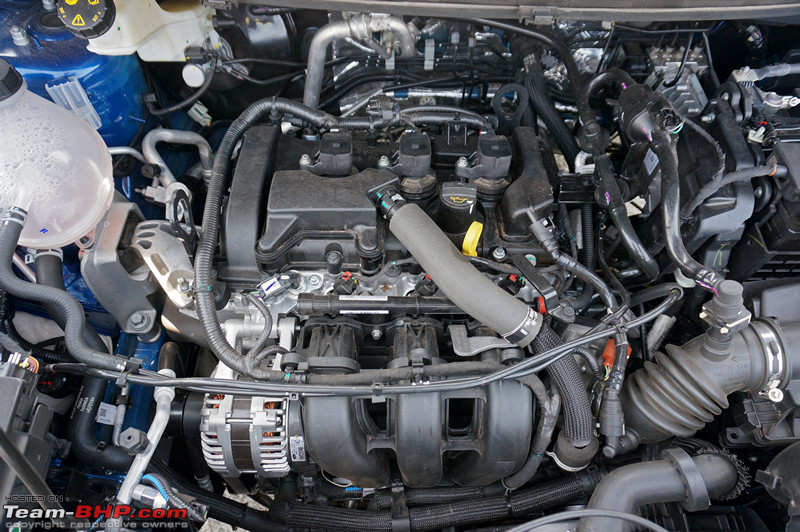 Plumbing for the air intake has changed. Intake is now located right at the front (all the better for sucking in cool air):  Even petrol variant gets an insulation sheet underneath:  Fair amount of cladding on the firewall:  ECU is well concealed:  Just like before, the petrol gets no underbody protection (note = diesel does):  Gas / lubricant sticker shows the various engine and gearbox combinations. From left to right - the 1.5L Dragon petrol + manual & 1.5L diesel + manual, 1.5L Dragon petrol + automatic & 2.0L GDI (gasoline direct injection) + automatic, 1.0L Fox (EcoBoost) + automatic and 1.0L Fox (EcoBoost) + dual-clutch automatic. Only the 1.5L Dragon petrol and 1.5L diesel are relevant to India:  Yellow plastic lever needs to be moved towards the left side of the car to unlock the bonnet. It feels flimsy:  5-speed MT shifter is shared with the Figo. It has a leather-wrapped knob, glossy black top with a dash of chrome and a leather boot. Chunky and nice to hold:  MID has a gearshift indicator that tells you to shift up or down to obtain the best fuel economy. It even shows which gear you should shift to, and that's not necessarily the next in line! As an example, if you are in 2nd and revving hard, it will tell you to shift straight to 4th. Even the AT gets one. But my God, look at those outdated dot matrix fonts!!!  Driving the 1.5L Petrol AT Like the AT that came with the old 1.5L Ti-VCT engine, this gearbox has 6 speeds, but it is not the same unit. While the outgoing transmission was a DCT (dual-clutch), the new one is a simpler old-school torque converter AT. It's not as fast shifting a transmission as a dual-clutch unit, but it is not slow either. We are frankly pleased with the move because the old DCT had poor long-term reliability (Moderator Khan_Sultan has already had the clutch pack & TCM changed on his Fiesta DCT). How's the new AT? In a nutshell, it does the job and that's it - doesn't overtly impress nor disappoint. Along with the 1.5L engine, the slushbox makes the EcoSport an effortless car to drive from point A -> B. Besides, one must remember that the EcoSport is the only sub-4 meter compact SUV to offer a petrol AT (at least until the Nexon AMT comes). What's more, Ford has also provided paddle shifters & a 'Sport' mode. With your foot on the brake pedal, press the engine start / stop button and the EcoSport petrol AT comes to life. Like the MT, upon startup, there is some body shake felt. While idling, there are the typical 3-cylinder vibrations creeping into the cabin, which are a turnoff. Otherwise, it's a quiet motor and NVH levels on the move are excellent for a 3-cylinder unit. A disappointing trait is that, whenever the gear shifter is moved from P to D or R, there is some transmission noise ('khatak') and a noticeable shake that can be felt in the cabin. At a standstill, you can revv the engine to a max of 4,500 rpm. The EcoSport AT moves off the line almost immediately upon releasing the brakes and crawls at ~6 km/h without accelerator input (useful in bumper-to-bumper traffic). When the car is driven in a sedate manner, gearshifts are smooth and you won't feel any jerk when they are being executed. With a light foot, upshifts are seen <2,000 rpm, while at medium throttle inputs, the transmission upshifts anywhere between 2,000 and 4,000 rpm. You will not even notice the gearshifts, except for a change in engine sound. The automatic gearbox, along with the small size of the car & light controls, makes the EcoSport an easy toy to drive in the city. As mentioned earlier, the transmission is not as quick-shifting as a dual-clutch unit, yet it is not slow either. There is a slight delay before a downshift is executed, but it's not so bad as to cause annoyance. On your daily drive through rush hour traffic, you'll only need to give the engine light accelerator inputs. Not too many downshifts are required either as the motor has a healthy bottom end. On the open road, the EcoSport has a good ability to cruise. Power delivery is linear & the gearbox does its work well. The AT cruises calmer than the MT due to the 6th gear - 100 km/h and 120 km/h are at 2,350 rpm and 2,800 rpm respectively. At these rpms, the engine is calm and composed. If one gets aggressive with the A-pedal, the transmission eagerly downshifts. Floor it and the box will take the engine to 6,500 rpm before shifting up. However, one will notice that this exercise results in more noise than an actual increase in speed initially. Coming to the shift quality, one will never find it getting jerky. The transmission is quiet in its operation too. You can use the manual shifting arrangement by pulling the paddle shifters (left to downshift & right to upshift). Most of the time though, it's best to use the regular D mode. Manual mode can come in handy when you need engine braking (e.g. going downhill) or when you want to bring the engine into its powerband before an overtaking move. Response times in manual mode are fair (not too fast nor too slow). Also, if you hit the revv limit of 6,500 rpm, it will shift up on its own (note: MT revs to 6,900 rpm). The EcoSport's slushbox also comes with an S mode which makes it more aggressive. The gearbox holds the engine revvs higher as well so that it's in the meat of the powerband (as a result, throttle feels sharper). Comparatively, in D mode, the engine revvs fall quickly. Like D, in "S" mode too, the engine shifts up at 6,500 rpm tops. While the EcoSport becomes more fun to drive in S mode (particularly on the open road), this mode is not desirable in urban conditions. The AT's ARAI-certified FE is 14.8 km/l. 6-speed AT gear lever comes with silver inserts and has a linear shift pattern:  Black unlock button is conveniently placed. I like the shifter's styling:  Traction control can be disabled (not really required in Indian conditions). A warning light appears inside the tachometer to indicate when the system is switched off:  Last edited by Aditya : 18th January 2018 at 10:58. |
| |  (54)
Thanks (54)
Thanks
 |
| The following 54 BHPians Thank Aditya for this useful post: | aeroamit, ajishanand, anshuman1117, Anupam1024, AShubrah, Avikbrio, blurust, Chrome6Boy, deetjohn, Dr.AD, Dr.Naren, espraveen, Flyer, frankmehta, GTO, IcarusMan, InControl, Jaggu, jithin23, Johnnny, Karthik Chandra, Keynote, Leoshashi, libranof1987, MSAneesh, Nohonking, Obi-Wan, Omkar, paragsachania, phoenixash, Punatic, R-Six, Rakshith220, RavenAvi, ravib, Researcher, rpunwani, samabhi, samaspire, shipnil, Simhi, sngautam, sparky@home, suku_patel_22, sunny29584, swiftnfurious, tharian, theexperthand, Turbanator, uday.ere, vaish9925, Varun_HexaGuy, vb-saan, X_T_A Rose |
| | #8 |
| Team-BHP Support  | Ride & Handling Like earlier, the EcoSport comes with an independent McPherson strut front suspension and a semi-independent twist beam rear. The EcoSport was never known for its absorbent ride quality. In this facelift, Ford has slightly softened the suspension. While there is a little improvement, the overall ride quality remains firm. At low speeds on less-than-perfect roads, bumps are easily felt & big potholes are prominent. Any comparisons to the magic-carpet-like Duster or WR-V are futile. You will always be aware of the kind of surface you're driving on. What makes it worse is Ford's poorly thought out decision of giving the top Titanium+ variant 17" alloy wheels! Such large wheels on a small car are simply impractical for Indian conditions. We also drove the Titanium variant which is equipped with 16" rims wrapped in 205/60 section tyres. Its low speed ride was better, but again, not what we would call plush (lowest variants with 15" rims should be the best of the lot). Still, the good news is, the EcoSport's ride quality is a tad more liveable now. And as the speedometer climbs, comfort levels only improve. It manages broken roads decently and tackles smaller potholes with ease. Larger bumps do make their presence felt though. The suspension is quiet in operation and goes about its job silently (not clunky or loud at all). The EcoSport remains a driver-oriented car. Its dynamics and poise are still excellent. The 205/50 R17 Bridgestone Ecopia tyres provide sufficient grip to keep most drivers happy. The car holds onto its line well and doesn't understeer easily. For a compact SUV, it can be thrown into corners with a good deal of confidence. High-speed handling is very predictable as well. Straight-line stability is excellent and the dynamics are safe overall. It's a lot more fun to drive than the Vitara Brezza. The electric power steering is light at city speeds; while parking or driving slowly, it is one-finger-light. At higher speeds, the steering weighs up, but not as much as enthusiasts would like. That said, the EPS isn't lifeless and does give you some feedback of what the front wheels are up to. At 200 mm, the car's ground clearance remains unchanged. We didn't scrape the underbelly anywhere. Even when we took it a bit offroad for photography, the Ford breezed through the terrain. The tallest speed breakers won't pose any problems. Along with the ground clearance, the EcoSport retains its turning radius of 5.3 meters. That's wider than the Nexon's 5.1 meters and the Vitara Brezza's 5.2 meters. The EcoSport has the ubiquitous front disc & rear drum braking setup. While braking from high speeds, the hardware is good enough to bring the EcoSport to a stop without drama. ABS + EBD are a part of standard equipment on all variants. The system is nicely tuned and not intrusive. Pedal feedback is good and you know exactly what the tyres are up to. Last edited by GTO : 16th January 2018 at 11:29. |
| |  (44)
Thanks (44)
Thanks
 |
| The following 44 BHPians Thank Aditya for this useful post: | aeroamit, ajishanand, Anupam1024, AShubrah, Avikbrio, Balaji31582, Col Mehta, deetjohn, Dr.AD, Dr.Naren, espraveen, Grease_Monkey, GTO, InControl, Jaggu, jithin23, Johnnny, Karthik Chandra, libranof1987, MSAneesh, Nohonking, Obi-Wan, Omkar, paragsachania, phoenixash, Punatic, R-Six, RavenAvi, ravib, rpunwani, samabhi, scwagh, Simhi, sngautam, sparky@home, strawhat, swiftnfurious, tharian, The Rationalist, theexperthand, uday.ere, Varun_HexaGuy, vb-saan, X_T_A Rose |
| | #9 |
| Team-BHP Support  | Other Points • Thanks to BHPians Ramzsys & Ravib for bringing us the first uncamouflaged pictures of the EcoSport facelift! • 1.5L diesel costs just ~70k more than this 3-cylinder petrol. It's a no-brainer choice. A turbo-charger, an extra cylinder, more torque (less power though), refined idle, superior fuel economy and arguably higher resale value. Why is the price difference so low? Because the diesel gets tax benefits which the petrol doesn't (read this & this); it wouldn't be the case if the petrol was a 1.2L. • Bookings opened on Amazon.com on November 5, 2017. Booking amount was pegged at Rs. 10,000. Ford claims that the 123 units that were available on Amazon were sold out within hours. Titanium+ variant with the 1.5L Petrol AT got the maximum orders (we'll take that with a pinch of salt), while Lightning Blue emerged as the favourite colour. • The doors do NOT auto-lock as you move along  . But they do auto-unlock when you switch the car off. Weird, no? I checked multiple times & through all the MID options, but there was nothing for auto-locking doors. Guess this is an error from the engineer's side rather than a cost cutting measure. But still, a serious slip-up as auto-locking doors are super important in India. . But they do auto-unlock when you switch the car off. Weird, no? I checked multiple times & through all the MID options, but there was nothing for auto-locking doors. Guess this is an error from the engineer's side rather than a cost cutting measure. But still, a serious slip-up as auto-locking doors are super important in India. • Diesel engine and 5-speed MT combination has been carried over from the outgoing EcoSport. 1.5L diesel has an ARAI rating of 23.0 km/l. • 5 variants - Ambient, Trend, Trend+, Titanium & Titanium+. The AT is available only in the Trend+ and Titanium+ variants of the petrol. • Fuel tank capacity = 52L (larger than its direct rivals). • Standard warranty of 2 years / 1,00,000 km. Extensions for the 3rd and 4th years can be purchased (as you know, we always recommend that). • 2 year roadside assistance is standard. Owners can purchase extensions for an extra 1 or 2 years. • Service interval of 10,000 km / 12 months. • Lower Trend+ variant with steel rims gets a spare wheel cover, but not the Titanium & Titanium+ which show off their 5th alloy wheel. • 17" wheels + Bridgestone Ecopoia combination appears unsuitable for Indian conditions with several owners complaining of tyre bulging issues. Disclaimer: Ford invited Team-BHP for the EcoSport test-drive. They covered all the travel expenses for this driving event. Last edited by Aditya : 19th February 2018 at 11:10. |
| |  (50)
Thanks (50)
Thanks
 |
| The following 50 BHPians Thank Aditya for this useful post: | aeroamit, ajishanand, Alfresco, anshuman1117, Anupam1024, aryayush, AShubrah, Avikbrio, darklord, deetjohn, espraveen, Grease_Monkey, GTO, heavenlybull, InControl, Jaggu, jithin23, Karthik Chandra, Keynote, libranof1987, MSAneesh, Nohonking, Obi-Wan, Omkar, paragsachania, PetrolheadBrat, phoenixash, Punatic, R-Six, RaghuVis, RavenAvi, ravib, rpunwani, samabhi, scwagh, shipnil, Simhi, sparky@home, strawhat, suku_patel_22, swiftnfurious, TDCi'd, tharian, The Rationalist, theexperthand, uday.ere, vaish9925, Varun_HexaGuy, vb-saan, X_T_A Rose |
| | #10 |
| Team-BHP Support  | The Smaller yet Significant Things Ambient lighting is available in the Titanium & Titanium+ variants. Lamps are located in the front footwells. There are 7 colours to choose from - ice blue, orange, soft blue, red, green, blue and purple. These can be selected via the touchscreen:  Apart from the Lightning Blue colour of our test car, the EcoSport is available in 6 other shades. Here it is seen in the Canyon Ridge shade. Other colours include Absolute Black, Race Red, Diamond White, Moondust Silver & Smoke Grey. The last three have been carried over from the old car, while all the others are new:  Very small 'petrol' sticker (no mention on the fuel cap). Ensure the pump attendant is made aware of her diet:  The EcoSport is equipped with automatic rain-sensing wipers. Sensor is located in the center of the windshield:  Orange indicator stays on whenever the car is locked from inside or outside (even when parked):  Door ajar warning is a new addition. It does not specify which door is open though. While it will come on if the tailgate is open, it doesn't when the bonnet is:  Depressions on the roof lining above the driver's sunvisor (where the vanity light & switch would have been) remind you of what you aren't getting:  Faux leather covers up the ugly gap between the dashboard & steering console - a premium touch:  Bonnet release lever feels economy-grade:  Fit & finish of some parts leaves a lot to be desired. The plastic around the bonnet release appears to be haphazardly cut:  Fit & finish at the ends of the dashboard is far from perfect:  It's the same at the top of the doorpad. While not many are likely to notice them, such irregularities have not been common in Ford cars:  PSI ratings for the different tyre sizes across all variants are uniform:  Seatbelt buckle gets a thick lining to prevent it from rubbing against & damaging the leather seat:  Brand new smartkey is nicely finished and feels premium. Skeleton key has been provided, but boot release button that was available in 2013 has been left out. Shiny black insert looks tasteful:  Quite obvious where Ford looked for design inspiration:  The EcoSport gets the "MyKey" feature that has been seen in recent Ford cars. To create a MyKey, the keyfob has to be placed in this slot under the front center armrest:  The owner of the car can set up a MyKey by accessing the creation process through the MID. Once the owner sets a limit on various parameters, he has to press the 'OK' button on the left spoke of the steering wheel and the MyKey will be active. The MID also displays the current MyKey setup. Either key can be set as the MyKey, this way the driver can still have the convenience of remote locking:  Through the MyKey feature, owners can set a speed limit, speed warning and enforce a cap on the maximum audio volume. The maximum speed that can be set ranges between 100 km/h and 130 km/h, while the speed warning can be set at 75 km/h, 90 km/h or 100 km/h. There is no option to set an exact limit of the volume. Owners can also set up the emergency assist and 'do not disturb' features. You can set & delete 'MyKey' profiles through the master key (main key). Give your chauffeur / excitable teenager the spare key and they shouldn't be able to change any settings. Feature can be of tremendous utility to fleet owners too:  Titanium and lower variants get spring-loaded grab handles above all the passenger doors. Both the rear units have coat / bag hooks:  No LED headlamps (which it should have got), yet the halogen projectors do a better job of lighting up the road ahead compared to the old car's lights:  With the high beam engaged, the throw is brilliant!  Titanium and lower variants get a standard day / night IRVM with a manual flick switch:  Space between the clutch pedal and center console is limited. If one with a large shoe uses the dead pedal, his foot can get stuck under the suspended clutch pedal:  The driver's foot frequently brushes against the steering column while operating the clutch. This gets irritating after a while:  Seatbelt warning light does not come on if you start the car and drive off without buckling up. It will appear only after the speed exceeds 20 km/h. It is accompanied by chimes & blinks. Then, it stays on for a while before going off. This entire process is repeated till the driver wears his seatbelt:  Every time reverse gear is engaged, this readout appears momentarily on the MID (so that you can switch it off if not required):  Last edited by Aditya : 17th January 2018 at 11:59. |
| |  (89)
Thanks (89)
Thanks
 |
| The following 89 BHPians Thank Aditya for this useful post: | .anshuman, aeroamit, AkMar, anshuman1117, Anupam1024, arunphilip, AShubrah, Avikbrio, bhavik.1991, BigBrad, car.lover, catchjyoti, CEF_Beasts, Chrome6Boy, damager21, darklord, deetjohn, Dr.AD, Dr.Naren, Dramitn, espraveen, fiat_tarun, Gamemaztr, GTO, heavenlybull, hiren.mistry, HR 16, icar, InControl, Jaggu, jithin23, jkumar007, Johnnny, JustStarted, jvm_1986, Karthik Chandra, Keynote, knightrider_7, Latheesh, Leoshashi, libranof1987, manoj_joseph78, mishraak, MSAneesh, N33raj, Nohonking, Obi-Wan, Omkar, paragsachania, phamilyman, phoenixash, PrasunBannerjee, Punatic, R-Six, RaghuVis, Ram78, RavenAvi, ravib, razer2911, revintup, RJ2285, rpunwani, sainyamk95, Santoshbhat, Scorpion 10, scwagh, sdp1975, shipnil, Simhi, sngautam, sparky@home, spectre13, strawhat, streetfighter, suku_patel_22, sunny29584, supertinu, swiftnfurious, tharian, The Rationalist, theexperthand, uday.ere, vaish9925, Varun_HexaGuy, vb-saan, VeluM, vishy76, X_T_A Rose, yogesh.8984 |
| | #11 |
| Team-BHP Support  | Re: 2018 Ford EcoSport Facelift 1.5L Petrol : Official Review Thread moved from the Assembly Line to Official Reviews. Thanks for sharing - Rating thread 5 stars! For those interested in the diesel, here is Jude300's awesome ownership report - link (Ford Ecosport 1.5L Diesel Titanium (Facelift) - The machine I love). Last edited by GTO : 17th January 2018 at 10:10. Reason: Link to diesel |
| |  (10)
Thanks (10)
Thanks
 |
| The following 10 BHPians Thank GTO for this useful post: | Aditya, AShubrah, chiefpk, Jaggu, jithin23, myavu, The Rationalist, uday.ere, vishy76, X_T_A Rose |
| |
| | #12 | |
| Distinguished - BHPian  | Re: 2018 Ford EcoSport Facelift 1.5L Petrol : Official Review Excellent Review, rating 5 stars  Quote:
Last edited by Dr.Naren : 16th January 2018 at 11:57. | |
| |  (9)
Thanks (9)
Thanks
 |
| The following 9 BHPians Thank Dr.Naren for this useful post: | Aditya, anshuman1117, AShubrah, Dr.AD, espraveen, nmenon, RaghuVis, Researcher, The Rationalist |
| | #13 |
| Team-BHP Support  Join Date: Feb 2010 Location: S'pore/Thrissur
Posts: 7,271
Thanked: 12,400 Times
| Re: 2018 Ford EcoSport Facelift 1.5L Petrol : Official Review Fabulous review! As usual, the attention to detail is immaculate  Even though this is a facelift, I guess the changes are more than what you see in a generation change for some of the VAG cars. The design now feels modern and relevant and can easily go on for at least 3 more years. And good to see that Ford have rectified one of the mistakes they did with the pre-facelift model by providing an AT in the top-trim. But someone up the hierarchy might have thought that customers would take them for granted if they give all the options; so they removed the petrol MT option!  |
| |  (3)
Thanks (3)
Thanks
 |
| The following 3 BHPians Thank vb-saan for this useful post: | Aditya, AkMar, bhavik.1991 |
| | #14 | ||
| Team-BHP Support  Join Date: Sep 2010 Location: All over!
Posts: 7,613
Thanked: 18,336 Times
| Re: 2018 Ford EcoSport Facelift 1.5L Petrol : Official Review Very detailed, yet crisp review, Aditya! Every minute aspect of the car has been covered so well, you've left SAs with very little to say. Thanks for sharing. Ford has done a terrific job with the EcoSport facelift; they've managed to make a very modern, well put-together car even better. Of course, it is not perfect (pricing, kitting w.r.t variants) but a spectacular product. Would I buy this again? Yes! But now, I'd be grumpy that Ford would make me pay way too much for the Titanium+ AT. The AT on Titanium is tremendously VFM. Quote:
Ford has outdone itself with the improvements inside; I'm mildly jealous at the amount of equipment offered. My '15 EcoSport Titanium AT is very well-kitted but I do miss auto-folding mirrors and electrochromic mirror with reverse display. And those paddle shifters; I wish my car had those! The other goodies: puddle lamps, re-worked glovebox, steering controls and headlight controls enhance the interiors. My only grouse is the very odd-looking ICE, which sticks out like a sore thumb, and the driver MID, which is too bland. A glaring omission is the continued lack of door handles on the variant with six airbags. Why! Almost every co-passenger in my car complains about this. Quote:
Umm, nope. The 2015-onwards version had this; just a warning, no mention of which door. Last edited by libranof1987 : 16th January 2018 at 12:44. | ||
| |  (10)
Thanks (10)
Thanks
 |
| The following 10 BHPians Thank libranof1987 for this useful post: | .anshuman, Aditya, bhavik.1991, chiranjitp, Karthik Chandra, Punatic, Ram78, RavenAvi, The Rationalist, vb-saan |
| | #15 |
| Distinguished - BHPian  | Re: 2018 Ford EcoSport Facelift 1.5L Petrol : Official Review Great Review Aditya  Whats with that plain instrument cluster ? Shocking underplay by Ford here. Its as if Ford think's once they have given a new & large infotainment screen on the dashboard so they can skimp on the instrument cluster  Also 17" rims (205/50) are a bold move but they could have gone wider may be 215/50 or 225/50, this would have added better looks and also some more cushion. But they chose skinny tyres to maintain FE i believe. Last edited by karan561 : 16th January 2018 at 13:02. |
| |  (4)
Thanks (4)
Thanks
 |
| The following 4 BHPians Thank karan561 for this useful post: | Aditya, chiranjitp, RavenAvi, vb-saan |
 |



